Now just what is going on here? Where are the Space Marines? This seems all wrong!
Breaking with generations of tradition, Games Workshop are launching 10th Edition’s Codex release cycle not with the power-armoured poster-children of the Astartes, but instead with the insidious and hungry forces of the Hive Mind. It’s devouring time.
We would like to thank Games Workshop for providing us with a review copy of the Codex, plus some of the miniatures featured in this article.
What’s In a New Codex?
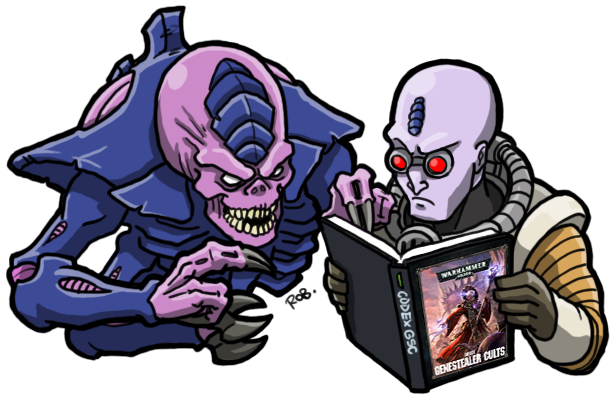
So the burning question up front, given that this is the first 10th Edition codex we’ve seen, is what does one of those look like? As might be expected, some things are pretty familiar to editions past (mostly the Datasheets and Crusade sections), but there are huge changes to the way army-level rules work thanks to the detachment system, and a new addition in the form of Combat Patrol rules.
For most readers, we suspect the detachment rules are what you want to hear about most, so let’s get that out the way. Rather than pages upon pages of stratagems, relics and traits that can be mixed and matched, when you play a Tyranid army you get a pair of Army Rules, which are always the same (Synapse and Shadow in the Warp, which are unchanged from the Index) and then select one of six detachments. These detachments each provide you with a Detachment Rule, similar to a Faction Trait in previous editions, alongside four Enhancements you can buy and six Stratagems. You only get access to the rules from the detachment you’ve selected, which makes the choice very impactful, and reduces the risk of there being too many nonsense combos lurking within (though there are bound to be some).
This is what GW promised during the preview period for 10th Edition, and it’s good that it’s not been immediately chucked out of the window with the first book. The other bit of good news is that they’ve stuck to the promise of Codex detachments being broadly on par depth-wise with Index ones – in fact, the Invasion Fleet index detachment is here unchanged, and honestly probably lands in the upper half on power level. That’s good news for everyone else, as it means that the pain of being without a full codex is going to be significantly lower than it has been the last few times, at least assuming that current stragglers get a bit of a boost.
It also, handily for the hard working content creator, makes unpacking the book quite a bit easier – there’s just less jumping back and forth when the relevant rules for each detachment are on a double-page spread. Top marks from us so far.
Army Overview
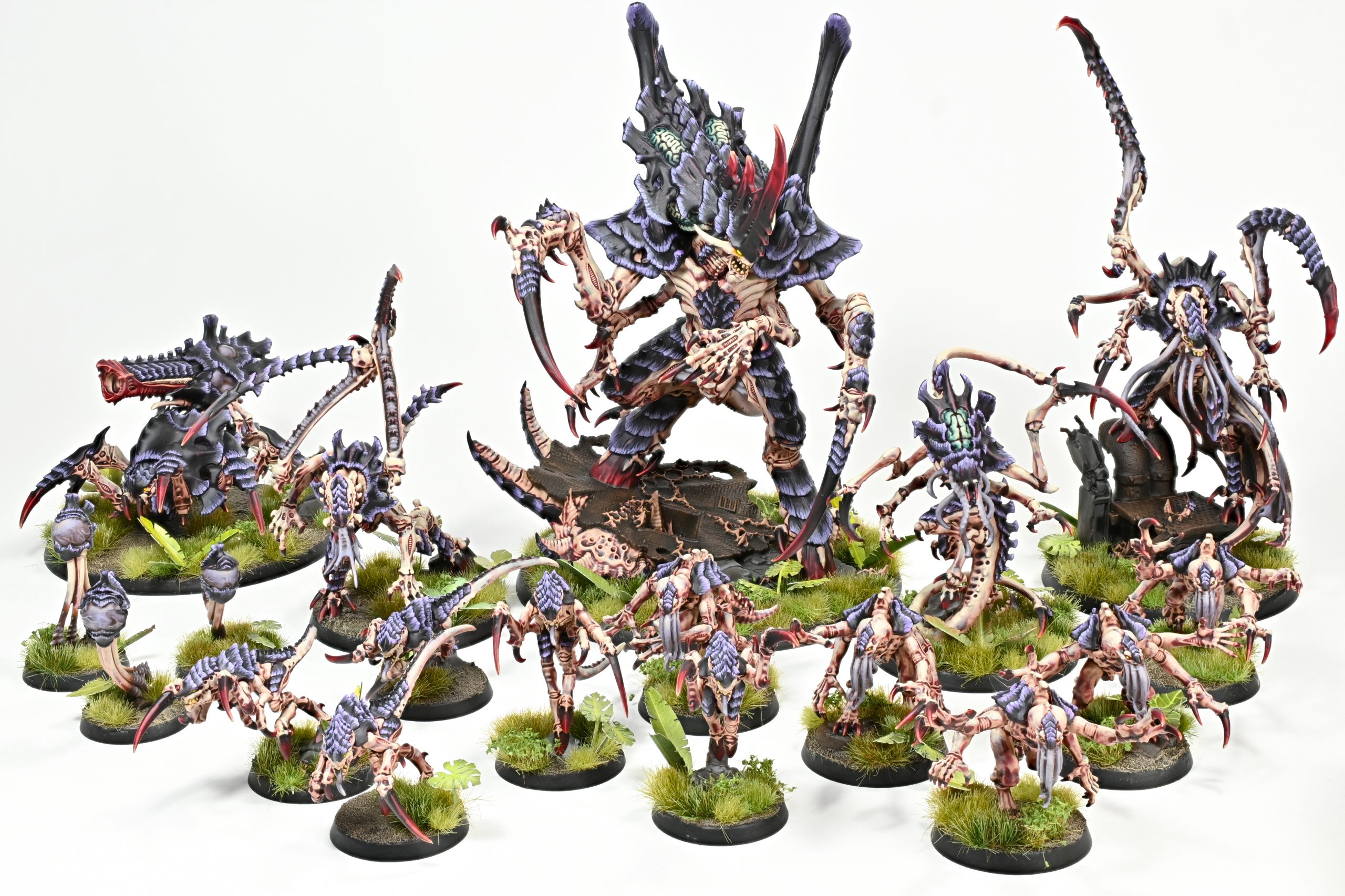
Tyranids are all about the beautiful belligerent bugs of many sizes, and the goal of the Tyranid Codex seems to be to offer you support for whichever category of beasty you prefer via themed detachments. You’ve got two “generalist” detachments (Invasion Fleet and Synaptic Nexus, the latter theoretically themed but functionally all-rounder), and then four that push different groups of bugs – specifically, big bugs, sneaky bugs, skittery swarmy bugs and hungry bugs. The last one might sound a bit out there, and it kind of is, but we’ll get to that.
We think the following are five standout features of this book:
- Apex Predators: The Norn Emissary provides an ultra-durable new top end for the army, giving them a serious anchor to build around.
- A New Mobility Build: The Vanguard Onslaught detachment unlocks a highly trick and mobility-based playstyle sure to appeal to those still pining after Genestealer tricks from 8th Edition.
- Fun for Horde Lovers: The Unending Swarm detachment looks like a whole tonne of fun for those who enjoy carpeting the table with Gaunts.
- Messing with Reserves: Two of the better detachments in this book break some new ground with how severely they can mess with the deep strike plans of the opponent, opening up some serious counter potential against armies like Daemons and Genestealers.
- The Transition from the Index is Pretty Smooth: We’re sure the magnitude of changes from Index to Codex will increase a bit over the edition, but right now this does solidly feel like a big expansion to the rules that Tyranid players have already familiarised themselves with rather than a massive overhaul, and if you want to just keep gaming with the Invasion Fleet and your existing army, that’s entirely supported.
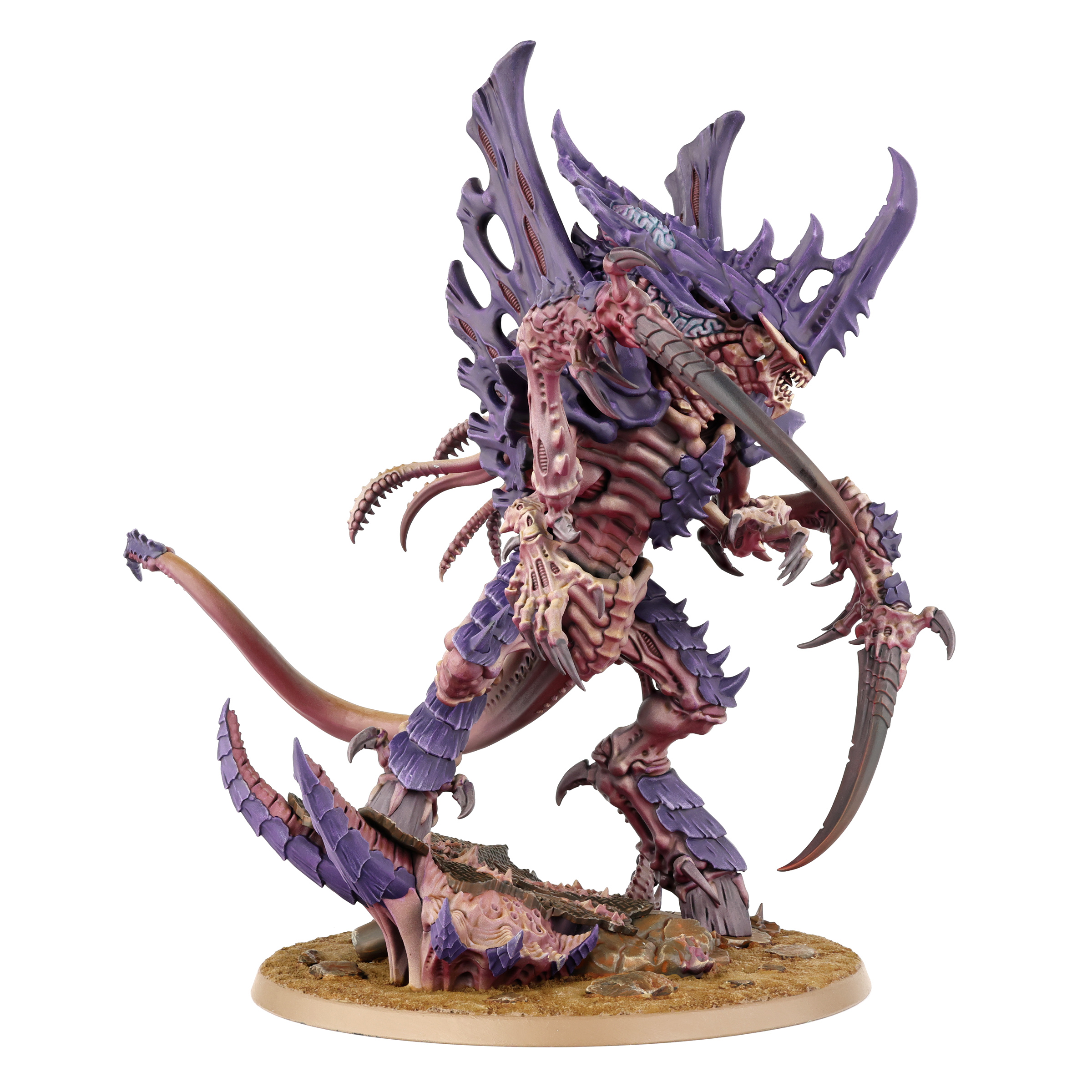
There are a few things that we’re not so hot on too:
- A Couple of Detachments Are Underwhelming: Crusher Stampede and the Assimilation Swarm are both distinctly weaker than other options in the book, the first because of some fairly cautious rules (perhaps unsurprising given what happened last time), the second because it’s tightly coupled to a very limited range of units. In some ways it’s not the end of the world, because you can just pick one of the four good ones, but it’s a bit of a shame, and it’ll be interesting to see over time how GW handle detachments that underperform from a balance perspective – do they get buffs, or do they get ignored as long as some of the detachments are getting there.
- Points Seem Vestigial: To our surprise, there are points in the book, albeit with a clear note that the most up-to-date ones are online, complete with a QR code directing you to the current points. We can sort of see the logic that it’s useful for people to be able to pick up and play with the book straight away, but we’re also sure that this is going to some way, somehow cause some really tiresome arguments. It is, admittedly, helpful for us to get a vibe for how expensive the entirely new stuff is.
Army Rules
If you select TYRANIDS as your Army Faction, you get not one but two army rules. These are unchanged from the Index, so if you’re familiar you can jump ahead, but if you’re newly biomass-curious, read on.
Synapse
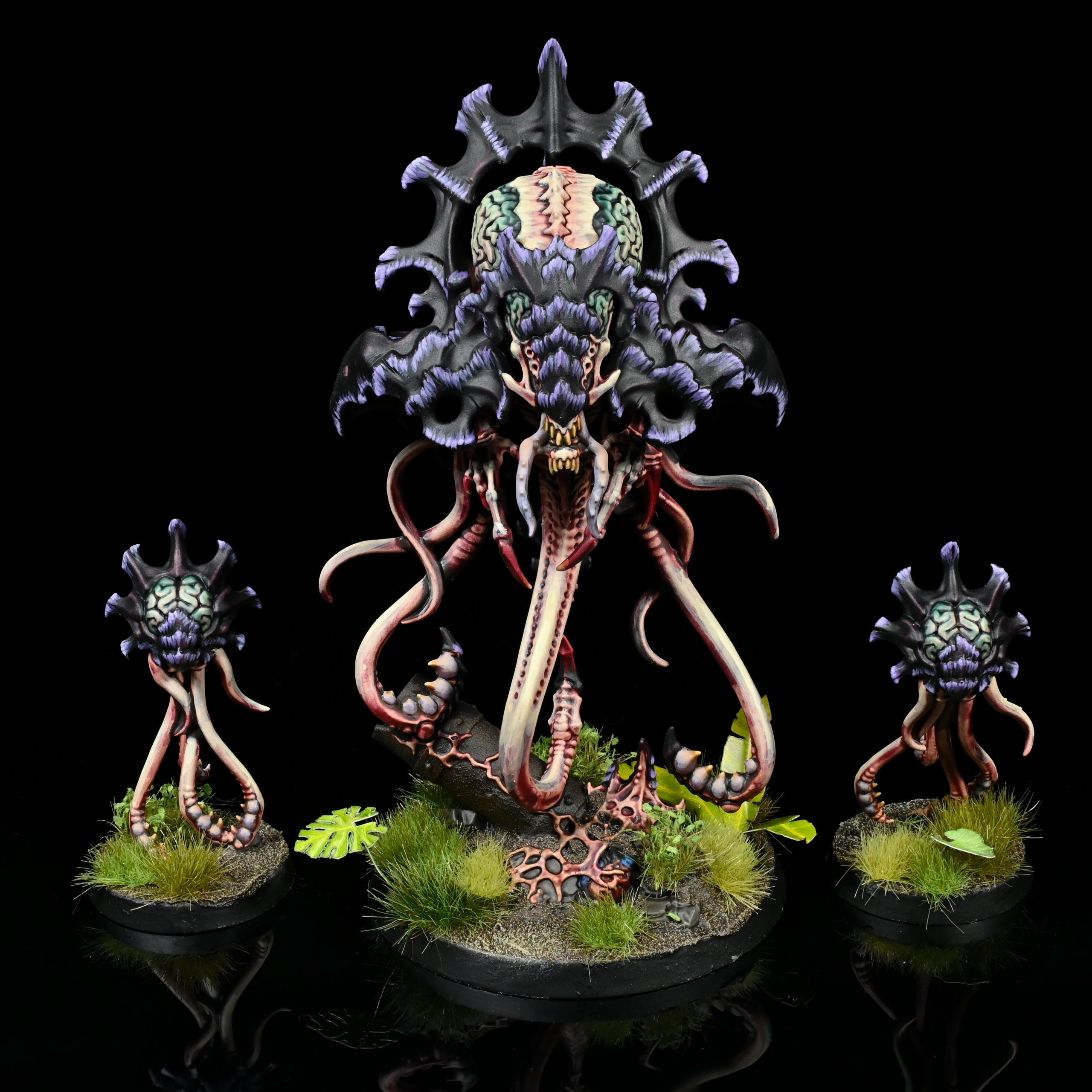
The Tyranids are controlled and animated by the will of the Hive Mind, which is channeled through some of the varieties of bug that make up their invasion fleets. These units have the SYNAPSE keyword, and as long as a unit with this Army Rule is within 6” of one of them, they are said to be “within Synapse Range”, and take their Battle-shock tests on 3d6 instead of 2d6. Some other rules within the detachments and datasheets also key off Synapse Range, but just at baseline this is pretty good, as your army is very resilient to Battle-shock as long as you keep them in good order. Beware though, as to compensate for this your Leadership values are generally one point worse than equivalent units in other factions, which means that as long as you’re in Synapse Range you’re still far more likely to pass a Battle-shock test, but outside it you’re a bit more vulnerable. It’s also worth highlighting that the way Synapse is presented on datasheets can be a bit confusing – every unit in the army lists Synapse as a Faction Ability, but this isn’t the same as having the SYNAPSE keyword, instead just indicating that it can benefit from this rule.
Shadow in the Warp
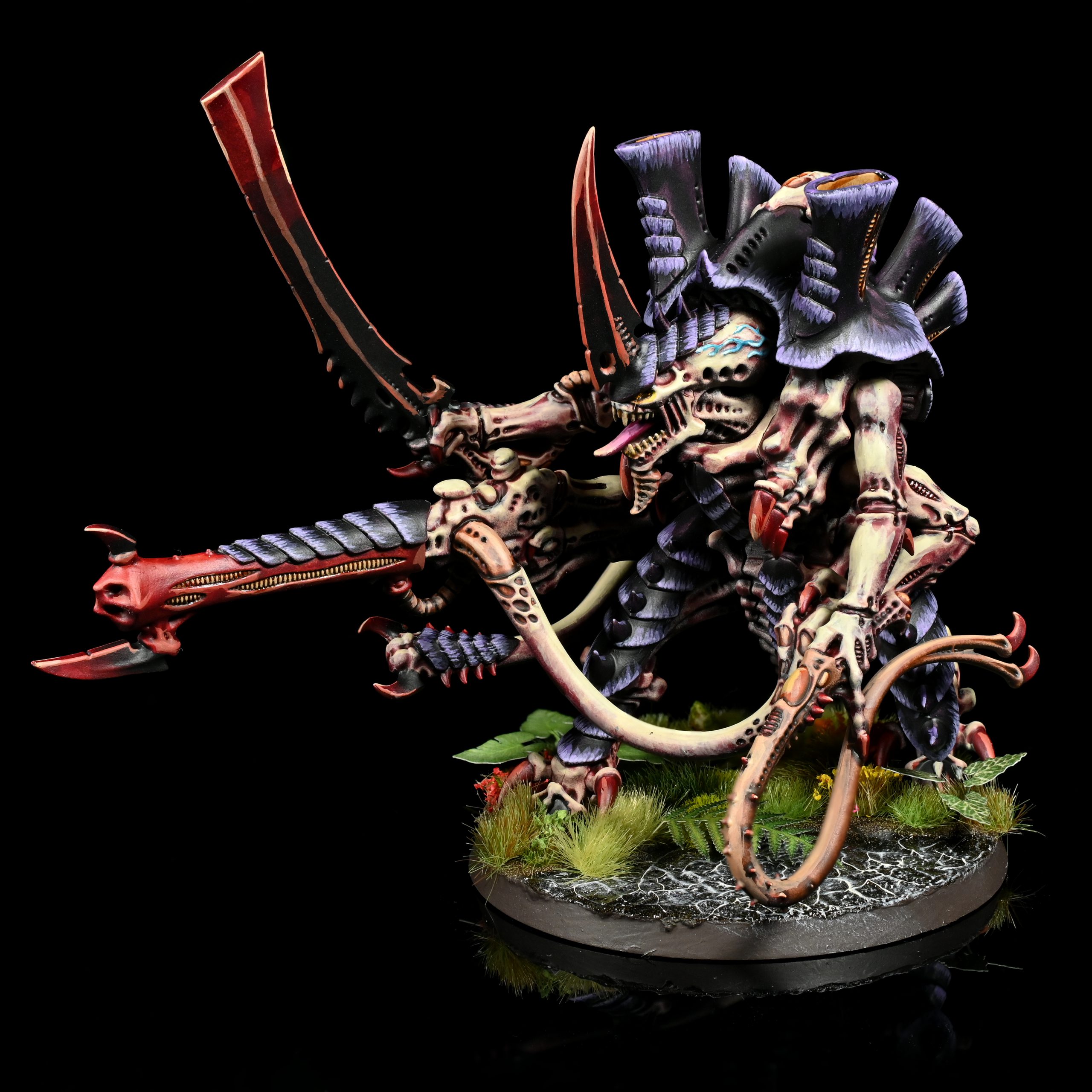
The Hive Mind doesn’t just affect the Tyranids – it also draws a psychic pall over the battlefield, striking terror and despair into those that stand in the way of the Great Devourer. To represent this, Tyranids get a second Army rule that appears on some of their units (generally SYNAPSE stuff plus a few special cases), the Shadow in the Warp. As long as you have at least one of those units on the table, once per battle you can unleash the Shadow in the Warp in either player’s Command Phase, forcing every single enemy unit to take a battle-shock test. This can be devastating to the opponent’s plans, loosening their grip on objectives and confounding any desire to use stratagems. If you’re using it in the opponent’s Command Phase, it also ends up meaning that any unit that’s below half strength has to take two tests in the phase – like all “in the Command Phase” rules that don’t specify otherwise, this happens in the Command step, prior to the Battle-shock step. Alternatively, while shocking an enemy in your turn is generally slightly less useful, it has the interesting subtlety that opponents cannot use Insane Bravery to avoid it – the “when”on this stratagem only allows you to use it in your own Command Phase, so it’s off limits during your opponent’s.
This is good in general, and there are also a healthy number of rules in here that reward you for battle-shocking the opponent, so it can also be helpful to set up combos.
Detachments
Right then. This is what you’re here for. Tyranids now have a mighty six detachments to choose from, which are:
- Invasion Fleet: Your all-rounder Index option.
- Crusher Stampede: Big bug bonanza.
- Unending Swarm: Hordes of Gaunts.
- Assimilation Swarm: Regeneration built around a new HARVESTER keyword.
- Vanguard Onslaught: Sneaky and speedy bugs galore.
- Synaptic Nexus: Build around your brainiest bugs and reap the rewards.
As the Goonhammer team has hungrily assimilated the contents of this book, our hive-mind consensus has ended up being that, broadly, the best three choices here are Invasion Fleet, Vanguard Onslaught and Synaptic Nexus, with Unending Swarm also having some appeal for dedicated hordes lists. Invasion Fleet is just a generally good set of rules, as can be discerned from it doing OK in the metagame so far, and Synaptic Nexus competes with it as a generalist choice, providing a powerful set of adaptable buffs and abilities, at a cost of needing to be more rigorous about staying in Synapse range.
Vanguard Onslaught is more of a divergence, putting the focus on units that have the Vanguard Invader keyword, which has been handed out fairly liberally (pretty much all sneaky things and anything with wings), and provides a whole host of tricky movement abilities to confound foes. What really lifts it above the other more specialised choices (above and beyond movement shenanigans basically always being great) is that it still provides some benefits to units that sit outside the specialist keyword, so you don’t have to commit 100% to the theme to get full benefit, providing good flexibility.
The other three Detachments are all very firmly tied to their favoured keyword, which constrains them somewhat. Unending Swarm seems like it has a strong chance of getting away with this, because the rules are all solidly pulling in the direction of a plan with a good pedigree, which is burying your opponent beneath a Gaunt carpet, and it plausibly does end up the best way of doing that. Assimilation Swarm, sadly, is in the weird position of having some pretty interesting and decent rules, but being tied to a keyword that only shows up on four firmly middle-of-the-road units, which kind of kills it. Finally, it looks like Crusher Stampede is in the sin bin for an edition after it dominated a stretch of 9th, as the rules are just underwhelming, and you’re almost always better running a Nidzilla army as either Invasion Fleet or Synaptic Nexus.
Invasion Fleet
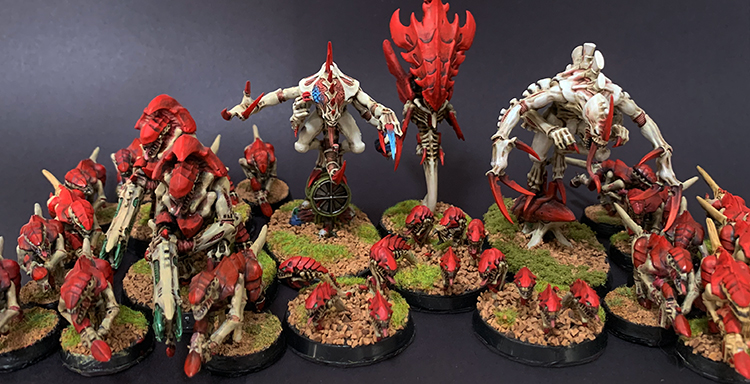
As befits the Index detachment, the Invasion Fleet is solidly all-rounder, providing some army-wide adaptability from the detachment rule, solid buffs for anyone in the Enhancements, and a grab bag of Stratagems covering lots of bases.
This is unchanged from the Index, so feel free to jump ahead if you’re familiar.
Detachment Rule – Hyper Adaptations
At the start of the first Battle Round, you choose one of three effects that affect all your units, all the time:
- Sustained Hits 1 against INFANTRY and SWARM units.
- Lethal Hits against MONSTER and VEHICLE units.
- Precision on Critical Hits against Character units.
The first two options are solid output boosts that can shore up your weaknesses depending on what the opponent is packing. The last one comes up a lot more rarely, as it’s much easier for opponents to play around, but luckily you can switch it on on-demand with the Predatory Imperative Stratagem, which lets you activate an additional one of these for a unit in Synapse range.
Enhancements
The Invasion Fleet gets two great general buffs for hefty CHARACTER monsters like Hive Tyrants, both of which have seen use in lists. Perfectly Adapted gives you one re-roll per turn that can be used on most kinds of standard roll, while Adaptive Biology provides a spicy 5+ Feel No Pain that improves to 4+ if you start any turn below your starting wound count. The former generally helps all-rounder Tyrants, while the latter is neat if you decide to go in on something extra chunky like a Tervigon. The other two open up the standard “redeploy three units”, which is fine but outmoded by a different version in this book and a boost to Synapse Range, which is useful enough.
Stratagems
Invasion Fleet’s standout stratagems are Rapid Regeneration and Overrun, the former providing a very solid defensive buff of a 5+ Feel No Pain (dropping to 6+ outside of Synapse Range) and the latter letting you either Consolidate extra far or make a Normal Move instead, allowing a bug to seize some space after killing something. Overrun’s value goes up a bit with this book, as Norn Emissaries rely heavily on being positioned correctly, so flexibility to shift where they’re standing is super helpful. Beyond those, turning on whichever of Lethal or Sustained you didn’t take when hitting a less common target in your opponent’s force is fine, and regenerating ENDLESS MULTITUDE models in your Command Phase with Endless Swarm can be handy
Crusher Stampede
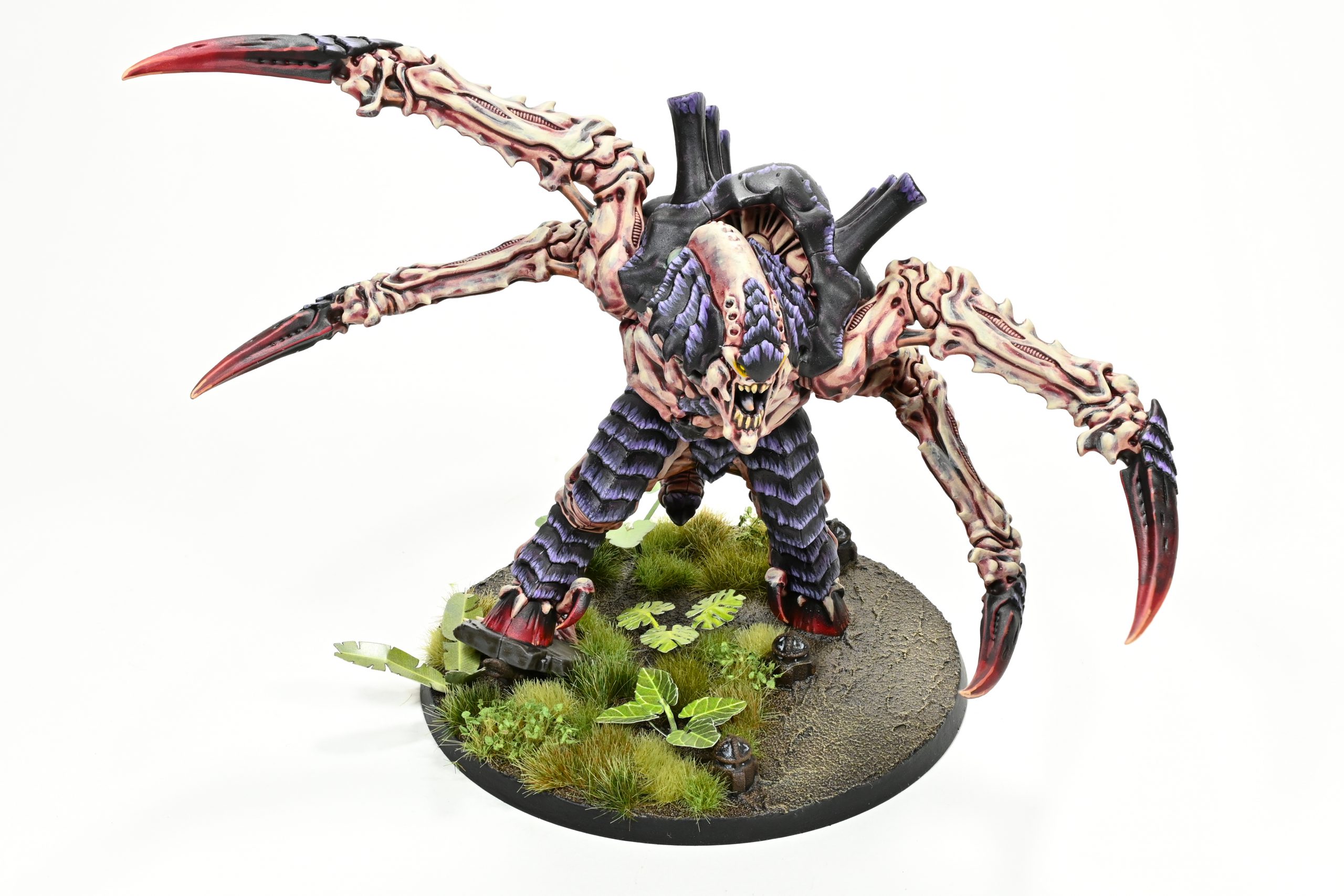
How the mighty have fallen. Crusher Stampede was the terror of 9th Edition, probably tied with the Harlequin Psychic Awakening for most impactful rules ever released in White Dwarf in the modern era. Unfortunately, this time around there’s been a serious overcorrection, and it ends up fairly weak, though there are still some fun things here. The detachment wants you to play with lots and lots of Monsters, and everything within is themed around that.
Detachment Rule – Enraged Behemoths
MONSTER units in your army that are below Starting Strength (which means losing any wounds for single-model units) get +1 to Hit, and those below Half Strength get +1 to Wound as well. Rules like this almost always end up a little underwhelming, because you don’t control when they’re active and you often don’t have access to them at key points in early turns, which is when you’re relying on your army to work at peak efficiency. It’s certainly better here than it is in some places it’s been used, as the durability of Tyranid monsters means that the opponent isn’t going to be able to avoid dinging them occasionally, but it’s still going to peak at affecting maybe a third of your army at once if you’re lucky.
The hit bonus also isn’t universally relevant, as plenty of spicy Monsters already hit on twos, and it runs into the general oddity that rules like this have, which is that two-model units are never Below Half Strength, which here means that the back half of this isn’t compatible with two-model Carnifex units. Just banging the drum here for my growing opinion that Half-Strength in general should be changed to “at or below” Half-Strength, as right now it’s a big tract of theoretical design space that in practice rarely does anything.
Finally, non-Monsters do not get a Detachment rule, so if you’re picking this, make sure you’re going hard on Nidzilla.
Enhancements
The Enhancements here are probably the biggest disappointment, with the straight buffs being pretty cautious, and the situational defensive tools being terrible. All of these are for MONSTER units only, and it feels like these were toned down because this is the Monster detachment, but get this – lots of the other Enhancements in this book can just be taken on Monsters.
The best one, and admittedly you will put this in every list you build with this detachment, is Monstrous Nemesis, which gives the enhanced model +1 to Wound in melee against enemy Vehicles and Monsters. Obviously this does clash with the half-strength effect, but not having to try and set that up is helpful, and can combine with Twin-Linked on Tyrants to make them a proper threat to large targets.
The other that’s OK is Ominous Presence, which gives +3OC. Not super exciting, but good on a Flyrant, as the difference between OC3 and OC6 is massive, since a lot of “medium-large” monsters are in the OC4-5 range. This allows a roaming Flyrant to maybe duel for objectives elsewhere while Norn Emissaries go for key targets.
The final two are bizarrely awful – one giving a 3+ to Fight on Death, the other a once-per-game 5+ Feel No Pain for a phase against Psychic Attacks only. Seeing the latter after the straight-up 5+ Feel No Pain that improves in Invasion Fleet is bizarre.
Stratagems
The Stratagems are something of a saving grace for this Detachment – not enough to make it a competitive choice, but they are good and will let you do some fun stuff with your monsters (and again, all of these are MONSTER only).
Rampaging Monstrosities is good, clean fun, providing full melee hit re-rolls, which massively ups the reliability of swinging with your hefty stuff, and is particularly good on things that already have Twin-Linked for wound re-rolls. The Swarmlord stands out in that category, and if you’re taking this detachment he’s likely in your list 100% of the time, as you’re going to want the CP.
Good, messy fun is Corrosive Viscera, your classic auto-explosion stratagem. It’s limited to non-FLY units, but it’s still great to have around, especially as you’re very likely going to be ramming Hierodules or Emissaries with d6 Deadly Demise into opponents with this Detachment.
You get some more general reliability boosts, and also an off-brand version of Tank Shock (I might have just gone with a Detachment Rule of “can Tank Shock like a Walker”, but whatever), and finally a very interesting and deceptively powerful Stratagem in Savage Roar. You activate this when an opponent swings at one of your Monsters in the Fight Phase, giving them -1 to hit and forcing a Battle-shock test, and if they fail they get -1 to wound as well. Tanking the enemy output is already great, but the Opponent’s Fight Phase is also one of the very best times to force an out-of-sequence Battle-shock test, as it can prevent them from successfully flipping an objective, which can seriously skewer their Secondary Plans.
As we said up front – these are genuinely really cool, and it’s kind of a shame some of the other aspects of the detachment drag them down. It does mean that if you want to slam the Swarmlord and a bunch of Hierodules in a list, you can have some fun here.
Unending Swarm

Credit: Pendulin
Endless, seething hordes of Gaunts is very much on-brand for Tyranids, and Unending Swarm has got you covered. The vast majority of rules here only matter for ENDLESS MULTITUDE units (the four flavours of Gaunt), with only the Enhancements really breaking out from that, but if you love burying your opponent under bodies there’s good news – this is pretty spicy.
Detachment Rule – Insurmountable Odds
All your swarms are Khorne Berserkers. Each time your opponent shoots with a unit, if it kills any models from your ENDLESS MULTITUDE units (and they aren’t currently Battle-shocked, then each unit that lost models can make a “surge move” of d6”, and must end the move as close as possible to the nearest enemy unit. They can end the move in Engagement Range if they can reach it, and crucially can do this as many times as they like each turn. This is obviously especially great with Hormagaunts, because if your opponent is trying to whittle them away a few models at a time, they’re going to get a claw to the face pretty swiftly, but it’s pretty good on other types as well, simply allowing you to totally bog down the enemy and overwhelm them on Primary (which is always going to be the plan for this kind of army).
It’s also got some great support from other tools in this detachment, as the way to work around this is to wipe whole units at once, and some strong defensive tools prevent that. It can also be pretty gnarly with Termagants, because you can use their Skulking Horrors ability to mess with the opponent’s calculations of how much room they need to leave by just ramming directly forward with that move as well.This feels potentially very strong, and can bury unprepared opponents under rolling waves of pressure.
Enhancements
The Enhancements in this detachment are a little weird, because they obviously have to go on Characters, but there are only two Leaders that can join Endless Multitude units, and the ones they can join aren’t even the iconic ones! Piercing Talons is probably the biggest victim of this, adding +1 to AP on Critical Wounds, which would maybe be OK on Hormagaunts, but you have no way to put it there! You can’t even settle for putting it on a Broodlord with some Genestealers, because they already grant Devastating Wounds to their unit!
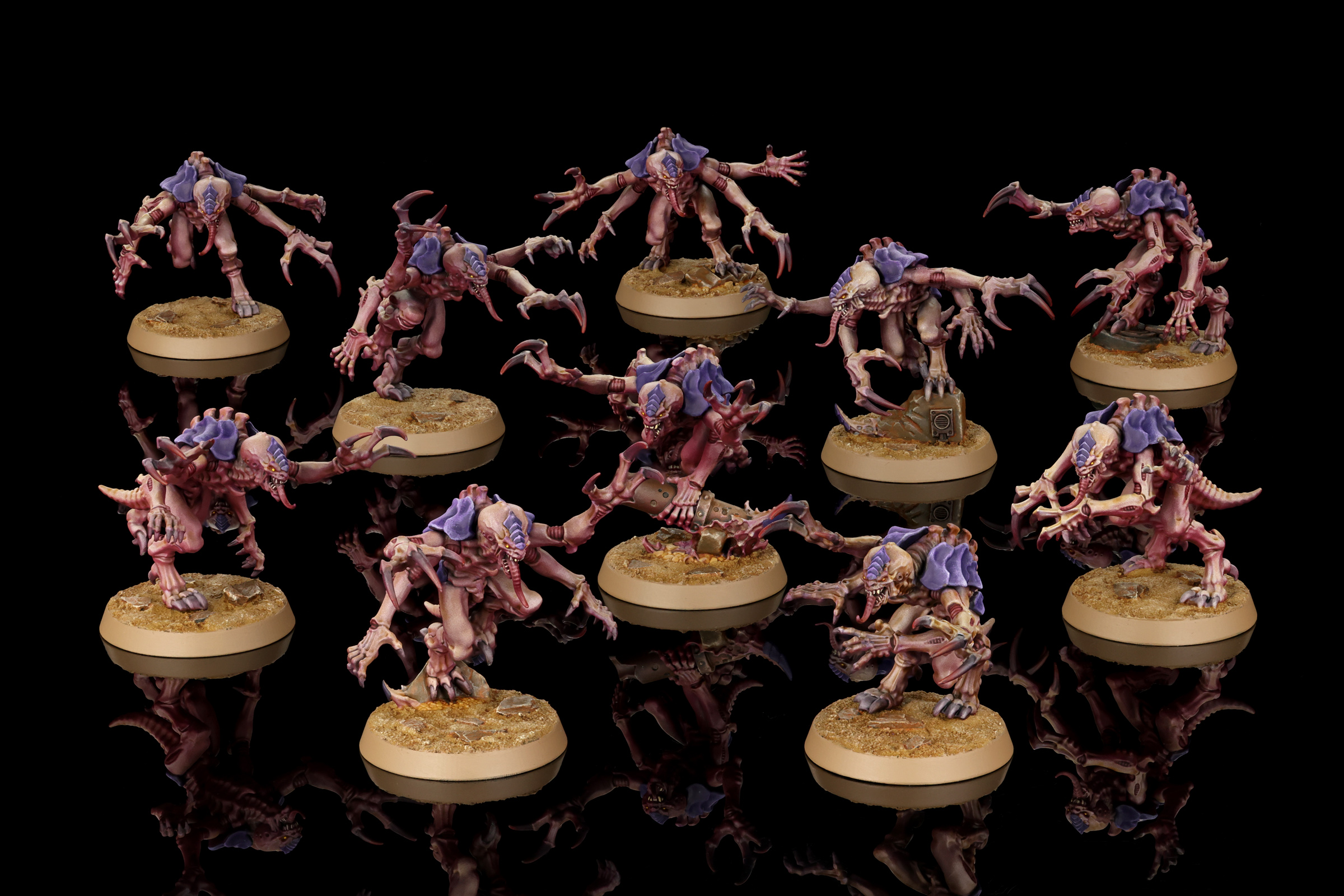
Slightly more plausible, both to combine with an Endless Multitude unit or to take on that Broodlord is Relentless Hunger, which provides +2” to movement for the unit. You could use this with a Winged Tyranid Prime to make an extra fast Gargoyle unit, which could be handy, or try for a turn 1 Charge with Scouting Genestealers then moving 10” (though realistically, with no stratagem support you probably don’t bother with those). I actually think the most likely use for this is with a Hive Tyrant and some Tyrant Guard, as I think there’s a good chance the list here ends up being that, Swarmlord, Venothropes and as many Gaunts as you can handle, just to power all the Stratagems. Extra move on big chunky things is always welcome. Adrenalised Onslaught also provides some extra mobility, boosting Pile-ins and Consolidates by 3”, but again really suffers from not being available to Hormagaunts.
Finally, one that I have mixed feelings on is Naturalised Camouflage, which lets the bearer pick three nearby ENDLESS MULTITUDE units at the start of the first Battle Round to count as being in Cover. This is definitely useful, but my initial thought was “why not just buy Venomthropes”? The answer, of course, is that this keeps working throughout the round, so if the opponent triggers a bunch of surge moves and you leave the protective bubble, it still on. It’s also notable that this doesn’t switch off if you move or anything, so if you go first you can still have your protection up as you close in. I’m still not totally convinced Venomthropes don’t cover you, as this also isn’t cheap, but it’s got slightly more potential utility than I first thought.
Stratagems
Right, strap in because these are absolutely lit. I was not joking that you 100% run the Swarmlord in this army, because you want as many CP as you can get. All of these are for ENDLESS MULTITUDE only.
Let’s start with defensive stuff – surge moves reward you for forcing the opponent to take more activations to clear your stuff, so anything that can reduce the number of models that die each time they do is very good. You have Teeming Masses for a nice, simple -1 to hit, but the real, unique all-star is Preservation Instincts. After an opponent’s unit chooses their targets for shooting, you can pop this on one of the units targeted, and for the rest of the phase count as having fewer than five models in the unit for the purposes of Blast. Not “five fewer”, “fewer than five”, so no benefit from Blast at all. Desolation Marine block got you down? Drop their shot count from 60 to 20. Mean Wraithknight bullying you? 12 shots down to 4. The Hive Mind has learnt to bob and weave, and the world better prepare. I also really like that this potentially punishes opponents who try to get too clever in playing round it, because if they split fire to minimise the shots they lose, that might just trigger more surge moves! Love this, great piece of design, and really helps this army work.
Also in that bucket is Synaptic Goading, which you can trigger when making a surge move to allow the unit to move towards the nearest objective instead of the nearest enemy. This can be great for scoring Primary, and is also much more likely to be deployable to let your unit hide mid-shooting phase, as going straight towards the enemy tends not to provide that.
More aggressively, expect both Bounding Advance and Swarming Masses to see plenty of use with Hormagaunts, and the latter to provide just a smidgen of the old devilgaunt energy to boot. Bounding Advance is a 6” auto-Advance, which isn’t flashy but is obviously great with Hormagaunts and their Advance/Charge capability. Swarming Masses is your force multiplier, providing Sustained Hits 1 when Shooting or Fighting, and also Critical Hits on a 5+ if your unit has 15+ models in it. That’s worth a bucket of extra hits on a full Hormagaunt unit, and Termagants with spinefists or devourers aren’t half bad with it either.

Last, but extremely not least, you have the holy grail of stratagems for this kind of army – the unit respawn. It’s 2CP, but lets you put a new copy of one of your units (sans leaders) into Strategic Reserves when they die, and given you’re relying on applying constant pressure to win with this kind of build this is incredible. Try and go into as many enemy turns with 2CP floating as possible, is all I can say.
I genuinely love the design on the stratagems here, because they really work well with what this detachment is trying to do, and definitely feel like they add up to a powerful package.
Assimilation Swarm
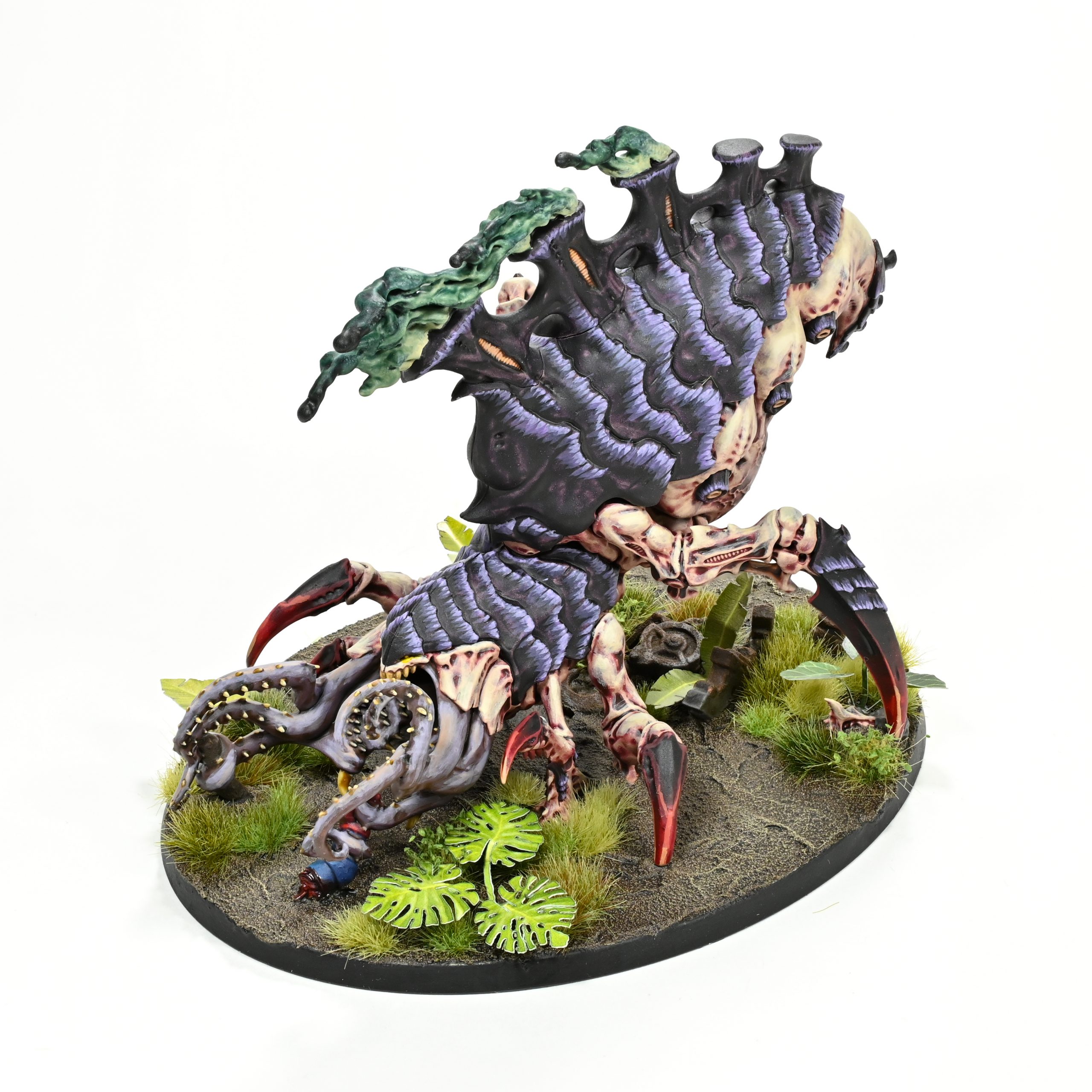
The weirdest wildcard of the Detachments here, the Assimilation Swarm is themed around HARVESTER units. What are those, you ask? Four whole datasheets – the Psychophage, Haruspex and Pyrovore, plus Ripper Swarms. This is…an odd set of things to try and build around, but the Haruspex and Pyrovore are at least fairly aggressively priced, so let’s see what we’ve got here.
Detachment Rule – Feed the Swarm
In each of your Command Phases, each HARVESTER unit that’s within range of an objective you control gets to heal a nearby friendly unit, either regenerating wounds or adding models back to INFANTRY units (each unit can only regenerate once). This is pretty neat, especially since they can just regen themselves if needed. It incentivises adding multi-model Pyrovore units to your army, as regenning a whole one is fully sick, and it’s also great if you can tag it onto Tyrant Guard. If you’ve brought some Endless Swarm units you can also use it for objective shenanigans, as they get to regen three models, which can seriously flip OC maths. There’s also no limit to the number of Harvesters that can benefit from each objective, so if you wanted to try a gunline, you could just have a few Ripper units hidden amongst them to hand out healing.
Enhancements
You may have noticed a unifying characteristic of those four datasheets – none of them are CHARACTERs. That means that like with the Swarm, these Enhancements have to aim to interact with the detachment’s deal without being directly on the relevant units. They honestly manage that somewhat OK. Biophagic Flow is the big obvious one here, providing an aura that boosts the reach of regeneration, and if you’re going in on this detachment hard then sure, you probably do want to go for that. It’s particularly good at helping your squishy Rippers stay hidden while still helping.
Next up are some options that help you protect your precious Harvesters, two different Enhancements that boost melee while in close proximity. Instinctive Defence gives a free Heroic and Fight First, while Parasitic Biomorpholoy gives +1S to melee weapons, and a permanent boost of +1A if they manage to take down a target within 6” of a Harvester. The former seems nasty on a brick of Hive Guard with a Tyrant (which you’re probably taking with this), while the latter is genuinely somewhat interesting on a full unit of melee Warriors with a Winged Prime – on a unit with Twin-Linked, the jump from S5 to S6 is massive (it’s basically the equivalent of the 4 to 5 jump in 9th), and if they get the extra attack at some point, so much the better.
Finally, Regenerating Monstrosity has the look of something that hurriedly had an extra rider slapped on in playtesting, because it lets the bearer be Regenerated twice a turn…but can’t be taken on Monsters. That leaves, for things you might profitably take it on, only the Winged Tyranid Prime and Broodlord, which is kind of whatever. I guess it’s actually not horrible on a full ranged Warrior unit, as they’re a pain to chip through with two models standing up a turn, but all the really fun stuff is cordoned off.
Stratagems
Once again, stratagems is where the really fun stuff is. First up, some boosts for your Harvesters themselves – either a 5+ Feel No Pain (increasing to 4+ if they’re in range of an objective you control) on the defence, or Lethal Hits and Critical Hits on 5+ on the offence. The latter can also be used on a non-Harvester, losing the 5+ Critical rider, but it’s pretty obviously intended for the Haruspex, which sports a massive number of attacks and will benefit hugely from it (and the defensive trick too).
Next, some interactions with the Detachment mechanic. Reclaim Biomass lets a Harvester trigger is regeneration effect when a nearby friendly unit dies, while Rapacious Hunger lets any unit regenerate after killing something in melee, and if it’s a Harvester it automatically regenerates the full three wounds. Both decent, and able to mess up the opponent’s planning nicely, though do kind of feel like things you could actually have made free stratagems as a reward for going in on this..
Finally, at a more meta level, we have Tyrannoformed and Broodguard Impulse. The former lets one of your Harvesters “sticky” an objective in your Command Phase, which is definitely strong, while the latter rewards you for sending Pyrovores and Rippers out to meet a glorious end. When a Harvester dies, you can pop this for a mighty +1 to wound from your entire army against the culprit for the rest of the battle, which is certainly extremely funny. Savvy opponents will probably try and play around this, but if you’re on this plan you’re presumably ramming three Haruspexes and lots of Pyrovores at them ASAP, so they may just have to scramble to remove stuff.
This detachment is kind of frustrating, because I like a lot of the design but the sheer narrowness of the unit pool makes it real tough to work with. It’s also got that problem of being very “clever” in the things you can do with it, but when you really drill into it it’s just making you jump through lots of hoops for a level of benefit that other things give you just for showing up.
Vanguard Onslaught
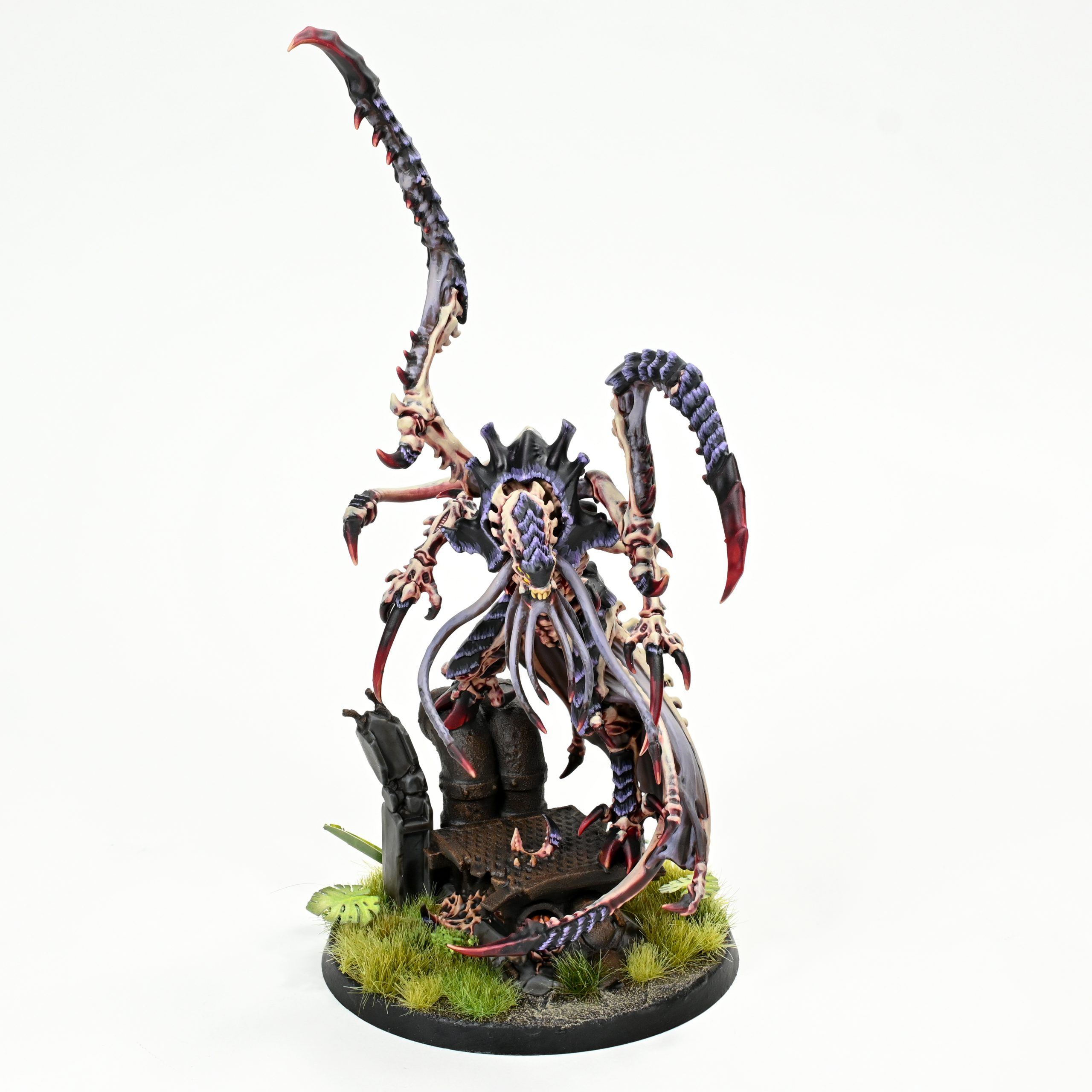
Right now we’re really cooking. This detachment isn’t going to frustrate you, but might very well frustrate your enemies thanks to a glorious array of tricks. It’s themed around the VANGUARD INVADER keyword, which appears on sneaky bugs, Genestealers and pretty much anything with wings. This immediately pushes it ahead of some of the other options, because there’s a pretty broad range and some really good stuff in there, but on top of that it’s also a bit more generous to units without the relevant keyword than some of the others. This one’s a good one, folks.
One specific thing worth calling out with this detachment – the Winged Tyranid Prime has the VANGUARD INVADER keyword, so attaching it to a Warrior unit lets them play with all the fun toys here!
Detachment Rule – Questing Tendrils
Start as we mean to go on here, with something for everyone, and extra bonuses for the VANGUARD. All your units get to Fall Back and Charge, and VANGUARD INVADER units can Advance and Charge. This is extremely spicy – it gets you legitimately close to considering Genestealers, means that Deathleaper can rampage around the battlefield killing stuff, and helps keep anything else you bring from getting bogged down in the wrong combat.
You also get a bonus detachment rule, which is that if this is the one you’ve chosen, you can make Deathleaper your Warlord. This doesn’t massively shake up anything you can do, but it means if you want to go seriously theme-heavy, you can.
Enhancements
There’s some definite goodness here. We’ll start with the more “normal” toys, which are some offensive/defensive boosts for VANGUARD units. On the offence, Stalker lets the bearer pick an enemy unit at the start of the battle, and have game-long +1 to hit and wound against the target. Neat, but only affects the actual model, which constrains it somewhat. The defensive tool is substantially better, granting Stealth and the Benefit of Cover against shooting. It’s worth noting that the Stealth isn’t conferred on a unit they join, as the whole unit has to have that ability to benefit (other similar enhancements grant this to the whole unit), but the Cover will. Realistically, though, where you take this is on a Flyrant, because flitting around on -1 to hit and an effective 1+ save feels distinctly like it gets this model over the line, particularly in combination with some of the Stratagems we’ll look at shortly.
The two more esoteric options are available to any Characters, and these are some of the big draws to the detachment. First up, Neuronode lets you redeploy three VANGUARD units at the start of the game, and specifically does so after the First Turn rolloff, unlike all other versions of this. That means you can be ultra aggressive with how you deploy some of your sneaky or infiltrating tools, then just pull them if the dice don’t go your way, and it gets even better when you factor in the Seeded Broods Stratagem we’ll look at in a sec. This is a 100% auto-take if you’re on this plan. Probably also seeing use in most lists is Hunting Ground, which is some armies’ worst nightmare. As long as the bearer of this is on the Battlefield, each time an enemy unit sets up on the battlefield you can roll a d6, and make them take a Battle-shock test on a 2+. As long as Genestealer Cults are a metagame force this is absolutely incredible, potentially thwarting their big alpha plans in a massive way, and it’s still good to force any other opponent to consider a ~30% failure rate for a simple plan of “deep strike onto an objective”. Great stuff.
Stratagems
The hits keep coming here, because this is basically “what if Tyranids, but also Eldar, a bit”. Sound good? It’s good, and honestly it’s hard to say where to start.
I guess let’s go with Seeded Broods, since we mentioned it already. For 1CP in your Movement Phase, this lets either two VANGUARD units or one other unit arrive from Deep Strike as if it was one Battle Round later. That’s a turn 1 Deep Strike right there folks, with multiple units if you’re feeling nasty, and thanks to Neuronode they can be units that you put on the board, pulled to Deep Strike when you lost the roll, then flipped back onto the board saying “psyche” come your turn.
That’s firmly middle of the road, as abilities in this detachment go, so let’s get to the really good stuff. Vanguard Onslaught gets both a “move 6” when the enemy moves nearby” Stratagem and a “pull into Reserves in the enemy Fight Phase” Stratagem, and in both cases you can either target two VANGUARD INVADER units or one other INFANTRY unit, giving you extra flexibility. Notably, if you’re going with the Vanguard option you are not limited to Infantry, so can cheerfully pull your Flyrants or whatever, and the general INFANTRY tag includes Zoanthropes, who love using either of these to dodge reprisals for their brain-genius crimes.
Also ready to confound the enemy is Unseen Lurkers, which lets you make one of your VANGUARD units untargetable outside of 12” when the opponent tries to shoot them (with the standard rider that they can then re-target). This obviously further helps with getting things like Flyrants into serious consideration, but you might be thinking “don’t half the themed units here have Lone Operative anyway”, and you’d be correct. Luckily, this is even better when used on those, setting the distance at 6” instead. Crucially, this means that your opponents reserves can’t come in and plan to shoot your Lone Operatives off the table, and can make it really hard to shift Deathleaper or a Neurolictor when it really matters, which is just excellent.
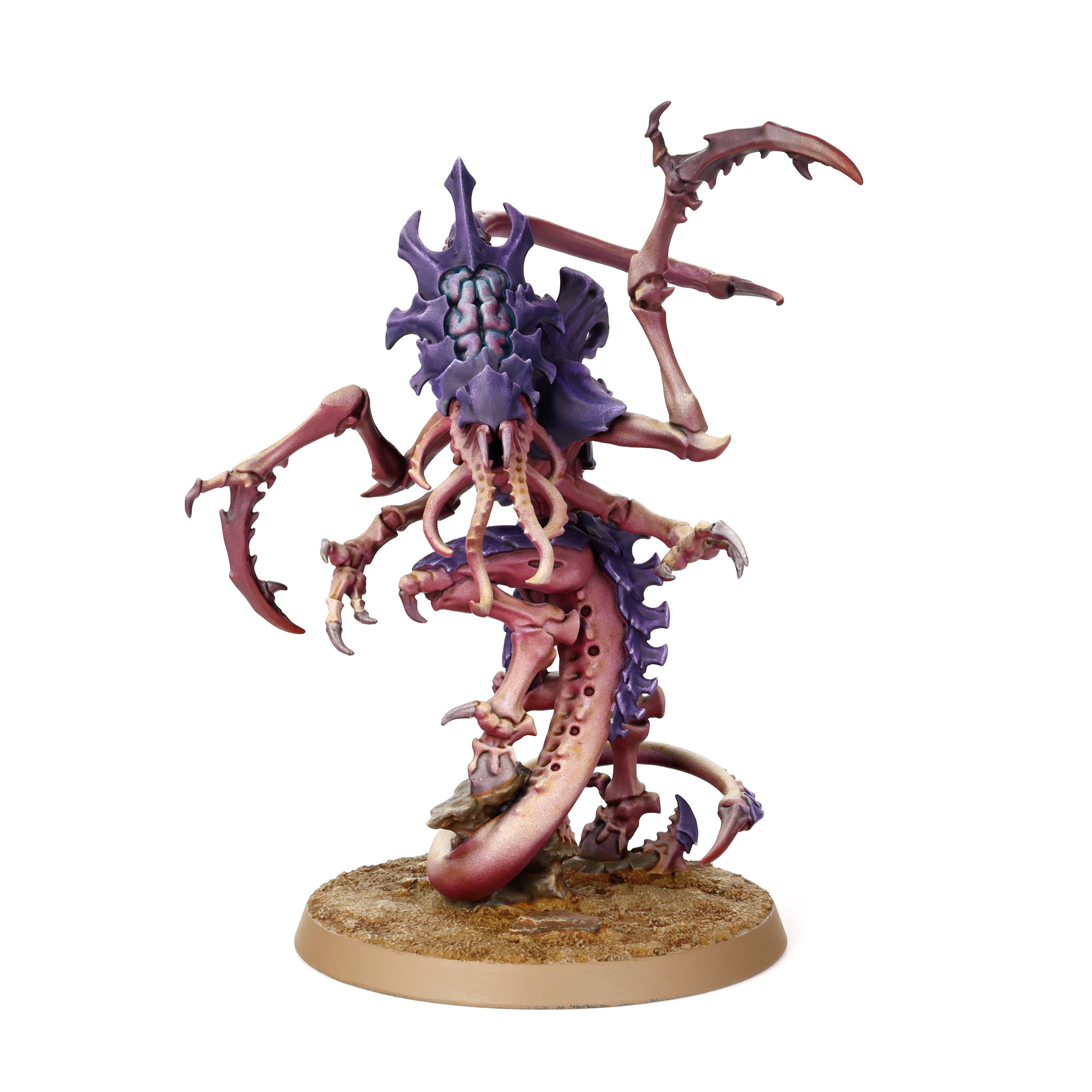
The closest to a dud here is Assassin Beasts, which gives a VANGUARD INVADER INFANTRY unit Precision in the Fight Phase (which many of them have anyway), but we return to “pretty good” but with caveats for the final one. Surprise Assault feels likely to get some errata, because it’s a bit weird right now, but it’s potent and crucially still decent if it receives the change we expect. You use this in your Shooting or any Fight Phase before a VANGUARD INVADER unit is chosen to shoot or fight, and pick an enemy unit, which has to take a Battle-shock test. Your unit gets +1 to hit them, and also +1 to wound if they fail the test. This is honestly kind of neat whenever on shooty Warriors with a Winged Prime, but the current weirdness with it is that there’s no requirement that the unit you choose be able to target or even see the enemy selected. That means that if you want your opponent to just randomly have to take a Battle-shock test on a unit that’s holding a crucial objective in their Fight Phase, you can just spend a CP to make them do that, which is certainly a useful tool to have in your pocket (especially with Neurolictors debuffing the opponent). Probably won’t last forever, but at least there’s a decent consolation here if/when it goes.
That sure is a lot of ways to ruin the opponent’s day. It may prove that this detachment pulls you away from some of the best datasheets a little too hard, but there’s some absolutely incredible effects available, and it feels like a definite contender for providing some of the better competitive builds out of this book.
Synaptic Nexus
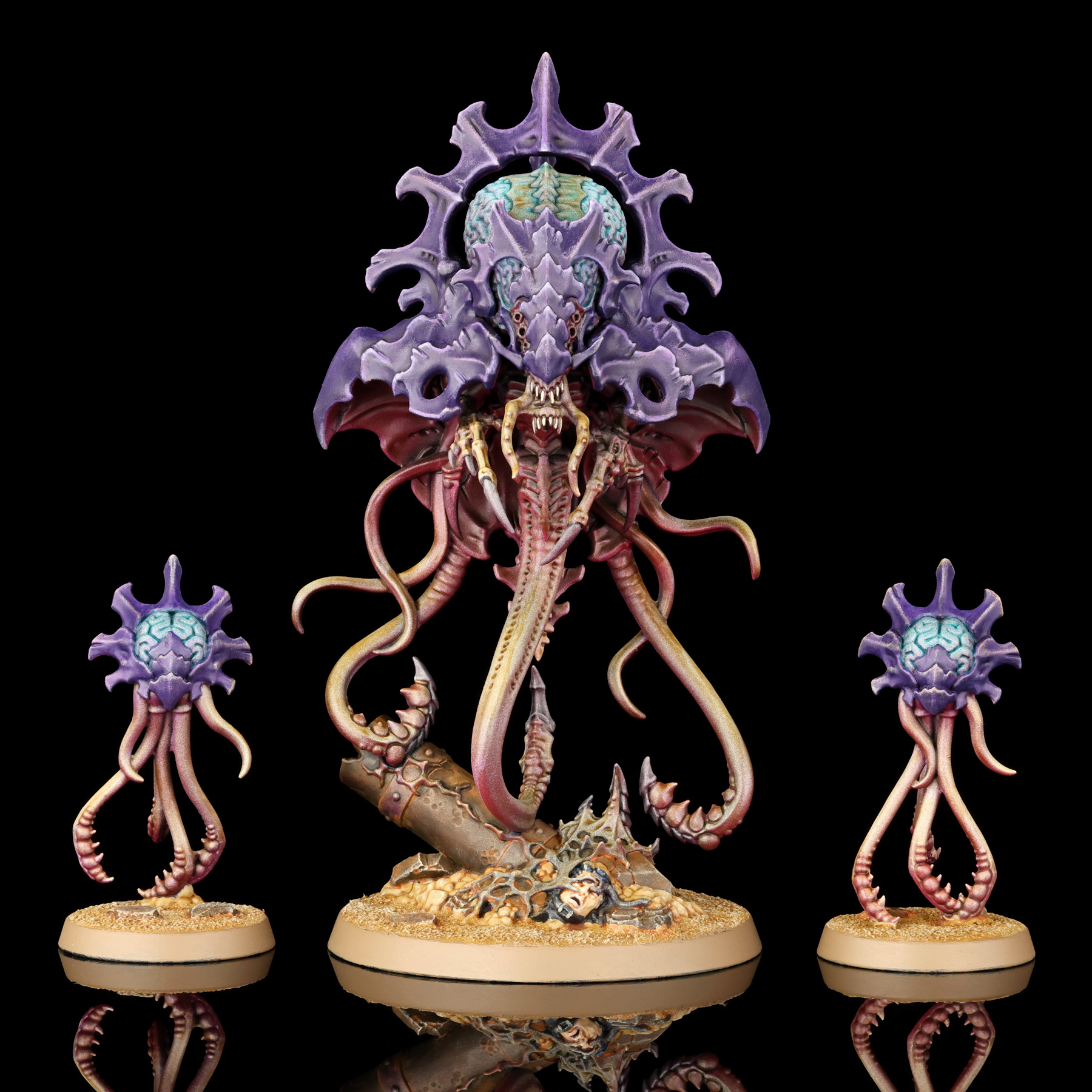
Speaking of good competitive builds – the last detachment here is another very strong-looking one. The Synaptic Nexus is themed around, as the name might suggest, Synapse critters, but because their whole deal is commanding and buffing others, it ends up bringing some very broad boosts to bear.
Detachment Rule – Synaptic Imperatives
Following a fairly common template for 10th Edition detachment rules, this one gives you three different buffs that you can choose to activate army-wide (or, army-wide for anything in Synapse range) once per game. Like most of these, it comes with the Imperative Dominance stratagem to let you activate one for a specific unit on top of that.
The buffs here are good, though unlike some other rules here I’ve actually cooled on them a bit the more I’ve thought about them, mostly because a lot of them are at least somewhat redundant when you consider the suite of units you’ll likely be using. Your options are a 5+ invulnerable save, great for keeping your teeming hordes alive early, +1 to Advance and Charge rolls, which is welcome for making sure an alpha turn lands, and +1 to hit in melee, which is great for the stuff that needs it, but a lot of your tools already hit on 2s. There’s certainly power here, but you need to be bringing units where the buffs aren’t redundant to get the most out of it. The 5+ invulnerable save feels plausibly like it’s the most relevant just because it massively extends the lifespan of big blocks of chaff Neurogaunts, but if you can keep them in Synapse Range some of the mid-grade monsters like Trygons and Mawlocs can squeeze value out of all of this stuff.
Enhancements
Look, the one that’s immediately going to catch everyone’s eye here is pretty obvious – Synaptic Control, which gives a SYNAPSE creature -1 to incoming damage. Crusher Stampede is slamming its claws on the table screeching “am I a joke to you?” even now. Sticking this on a Tyrant or Tervigon is a no-brainer. Or possibly a big-brainer, given the theme.It’s even priced solidly middle-of-road rather than at the top end.
Also very appealingly priced is Power of the Hive Mind, which is a boost of +1 to S and AP for Psychic weapons that a model has. You may be racking your (massive) brain for which units can actually take this and have it matter, and the answer is exactly and only the Neurotyrant, as everything else with a Psychic weapon is either not a Character (Maleceptor, Norn Emissary) or an Epic Hero (Swarmlord). Luckily, spending 10pts to up a 2d6 shot D2 flamer to S6 (again, a crucial breakpoint) and AP-2 is, and I’m checking my notes here, “extremely good”, so if you have a Neurotyrant in your list (something this detachment broadly encourages), you should pretty much slam this every time.
Another windmill slam follows in Psychostatic Disruption. This is pricier but it’s a good one, giving the bearer the always welcome 12” anti-Reinforcements bubble. This would be good anyway on the fairly large models that can take it, but it comes with an additional nasty bonus on top. Once per battle in the First or Second battle round, when the opponent tries to deploy a unit from Strategic Reserves, you can choose to try and stop it on a 4+. Make the roll? They’re waiting till next turn, which is crazy good when it works. It is important to highlight that this only works on Strategic Reserves, not natural Deep Strikers, but don’t forget that this does include any units the enemy pulls using redeploys, which is particularly relevant against Genestealer Cults, as they often use a Primus to pull three additional units off the board into Strategic Reserves at game start. Juicy stuff, and certainly if the current metagame endures you’re likely to slam this.
Finally, a bit less exciting to finish is the Dirgeheart of Kharis, which is just a big aura of -1 to Ld. I’m honestly not even sure this is actually bad as it can stack up on top of some other things to give opponents serious Battle-shock headaches, but if I’m building a list with this detachment I’m generally pretty excited about taking the other three.
Stratagems
We’ve covered one of these above already, so that leaves us with five tools. First up, we have a big, nasty punish for any opponent that fails a battle-shock test – if they do so within 12” of a Synapse creature, you can activate The Smothering Shadow and inflict mortals wounds (6d6 dealing mortals on a 3+, so four on average). Once you factor in Neurolictors, this army can force quite a lot of battle-shock tests, and this can be massively confounding to enemy plans. Don’t forget, too, that if you have an effect that forces a test, you explicitly can use this on something that’s already shocked in order to trigger additional rules that happen on failure, so if you’ve tapped something with this in a Command Phase, you can potentially do it again later in the turn with an alternative trigger.
Next is one of the big draws for this detachment – Irresistible Will. Pick a Synapse unit, pick a visible enemy within 24”, and then for the rest of the phase (shooting or fight) your Synapse unit has a 6” aura that provides re-roll 1s to hit and wound against that target for all Tyranid units. This is super strong, and the big obvious use case is with Zoanthropes – a unit of six is perfectly happy just popping it to boost its own attacks, never mind whether they’re buffing anyone else. Slamming it on Maleceptors and Norn Emissaries for a go turn is also very tasty.
Another great tool for Norn Emissaries is Reinforced Hive Node, an Armour of Contempt-style -1 to incoming AP for SYNAPSE stuff. These effects are always at their best on units with a 2+ save, and can make killing an Emissary even more challenging than normal. It’s also good for protecting Tyrant Guard, as having a Hive Tyrant with them makes them eligible.
Boring but practical stuff to finish – you’ve got a Fall Back/Shoot/Charge for something in Synapse range in Override Instincts (again, super good with Zoanthropes) and a boost to Synapse range in Synaptic Channelling, which probably won’t come up that often, but when you need it, you need it.
I think my concerns around the detachment-level buffs being somewhat redundant on the units you want to take here are plausibly valid, but the Enhancements and Stratagems are very strong here, so expect to see plenty of use from this detachment.
Datasheets
Onward to datasheets. First up, good news – the design of these has changed slightly to make them more space-efficient, incorporating the (much better) positioning of invulnerable saves from the Forge World indexes, and putting Leader stuff on the front page with everything else. There’s one unit in here that has to be extended to a whole page to cater for this, but on everything else it’s far more readable.
In terms of what’s here – everything you’d expect, and some new friends. We’re going to take a little bit of a different tack with these than we have in the past, because many datasheets are completely unchanged from the Index, which we already have thoughts on here. Rather than trying to hit everything, we’re going to look at:
- New Datasheets
- Datasheets that have changes.
- Datasheets that gain a big boost from one of the new detachments.
First up, therefore, new bugs!
New Datasheets
Tyranids have three new datasheets, covering the two mighty Norn beasts and the sneaky Neurolictor.
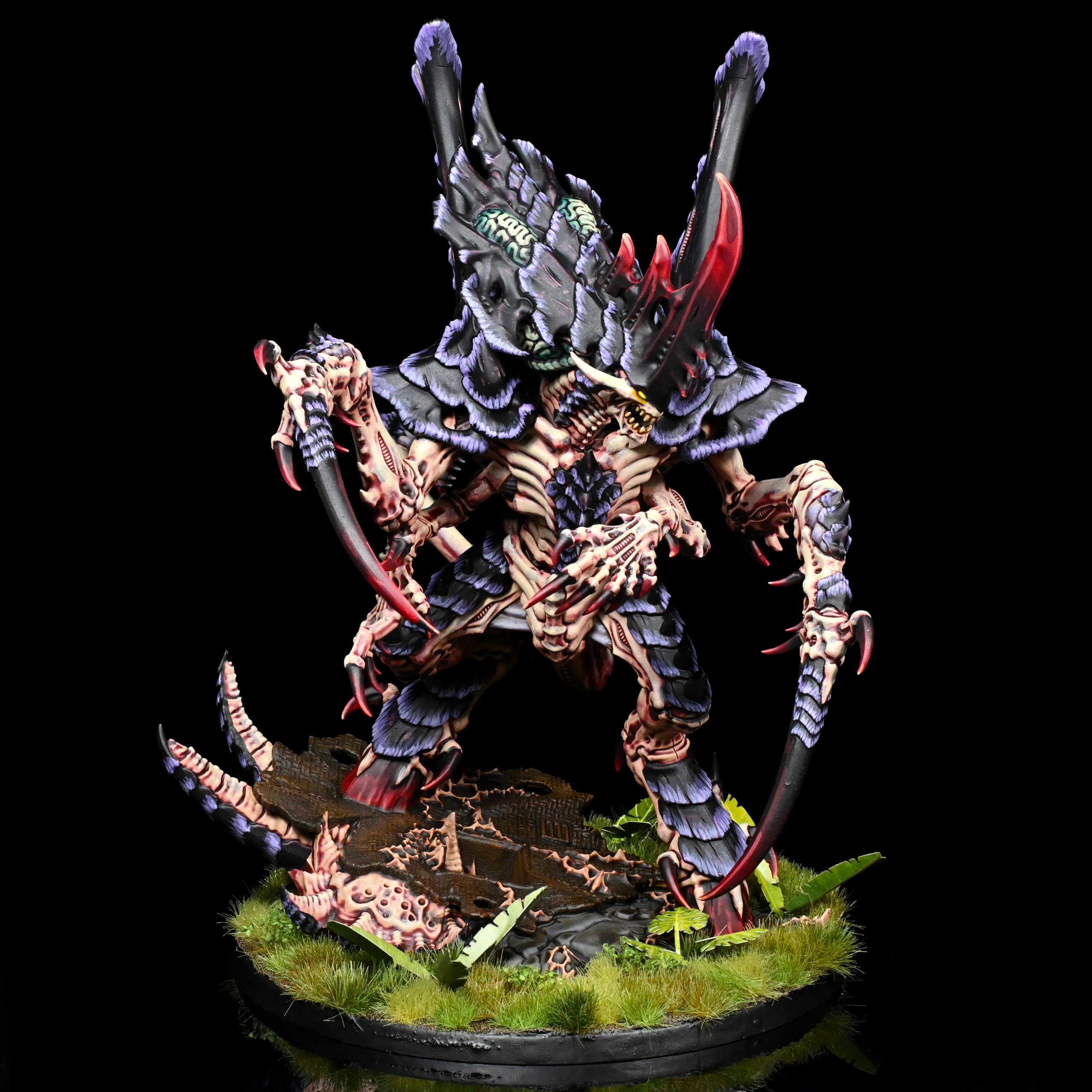
The Norns are big SYNAPSE (though notably not CHARACTER) centrepieces that share the Singular Purpose rule, which lets you select their goal at the start of the first battle round. You pick either an objective or an enemy unit, and the model becomes very good at either grabbing the objective or murdering that target in particular. If an objective is selected, then while in range of it your OC increases to 15 and you get a 5+ Feel No Pain, while if an enemy is targeted you get full hit and wound re-rolls against them. The latter is very neat, and I’m sure it will come up sometimes, but the objective option is incredible. Both these models have a daunting T11, 2+ save and 16W, and sticking a 5+ Feel No Pain on top of that makes them ultra tough to shift. OC15 is also seriously tough to beat even if the opponent has high OC stuff of their own, and this is great for stamping a claim on an objective then daring an opponent to try and steal it.
Both can thus be used pretty similarly, so it’s worth looking at how they differ to decide which we want. The Norn Emissary is the tougher and branier of the pair, sporting an always-on 4+ Feel No Pain against Mortals and a 4+ Invulnerable save, along with a varied-mode Psychic shooting attack that has your choice of anti-tank, anti-horde and anti-character profiles. The Norn Assimilator is all about smashing your opponent’s big targets to bits, sporting the ability to shoot anti-tank harpoons, giving it a bonus to charge if it hits a big target, and also being better able to smash them in melee. Both flavours of Norn have the same “main” melee weapon, which is 6A S9 AP-2 D3 claws, but each also has an Extra Attacks weapon, and where the Emissary just has some smaller D2 claws, the Assimilator swings four times with its harpoon profile, which hits at S12 AP-3 for big damage, making it far more of a threat into larger targets even without going re-roll mode. It also punishes stuff that tries to flee, getting to inflict d6 Mortal Wounds on a 2+ against an enemy that Falls Back from it once per turn.
Lots of exciting, splashy stuff from the Assimilator there – but we think the slightly more boring but very effective Emissary is likely to see more play, as extra defences align better with the role of going godzilla mode on an objective. The points in the book also have it as 20pts cheaper, further incentivising it, though obviously that could change in the digital version.

Speaking of very effective, buy some Neurolictors. These are incredible – for 60pts (again, in the book) you get a VANGUARD INVADER Lone Operative that Infiltrates, is incredibly durable for that price point (T5, 7W, Stealth, 4+ Invulnerable save), and uses its massive brain to cause opponents big headaches. You get to pick an enemy unit within 12” of it and force a Battle-shock test in your Command Phase, which is strong just on baseline (as it’s before objective control is evaluated for your turn), and woe betide any opponent that fails, because anything within 12” of this that is shocked gets -1 to its hit rolls while becoming far squishier when targeted – your whole army gets +1 to wound against them. Their only teeny, tiny drawback is that their melee is a bit less effective than regular Lictors, only hitting at D1, but who cares when you get this much utility for that price. We do not think you can possibly go wrong if you immediately buy two, and there’s a strong argument for three. Always emotional, seeing the first new unit of an Edition that (probably) sells out on preorder day.
Updated Datasheets
A reasonable number of datasheets see small updates from the Index. One of these reflects an FAQ that’s already been applied (Barbgaunts only affecting one unit that they hit) but there’s plenty of new stuff too, some of which maybe gives small hints about general design direction. As well as the stuff listed here, various units get the new HARVESTER and VANGUARD INVADER keywords added.
First up, let’s hit buffs. These affect:
- Neurotyrant
- Termagants
- Pyrovores
- Deathleaper
- Biovores (who also get a nerf)
The Neurotyrant furthers its pitch for inclusion in a Synaptic Nexus with an extension to the range of its Neuraloids, which can now be handed out at 18” instead of 12”. This is definitely handy in the Nexus – some of their buffs work best on stuff like Trygons and Mawlocs that want to range far from the main force, so being able to get them in Synapse could be valuable.
Termagants get access to some (optional) free special weapons to reflect the new sprue, getting one spikerifle, one shardlauncher and one strangleweb per 10. The shardlauncher and strangleweb are pretty much auto-takes that just always make your unit slightly better (particularly the Torrent and Devastating Wounds strangleweb, because two in a 20-model unit is suddenly an Overwatch concern), while the rifle is kind of bad and skippable.
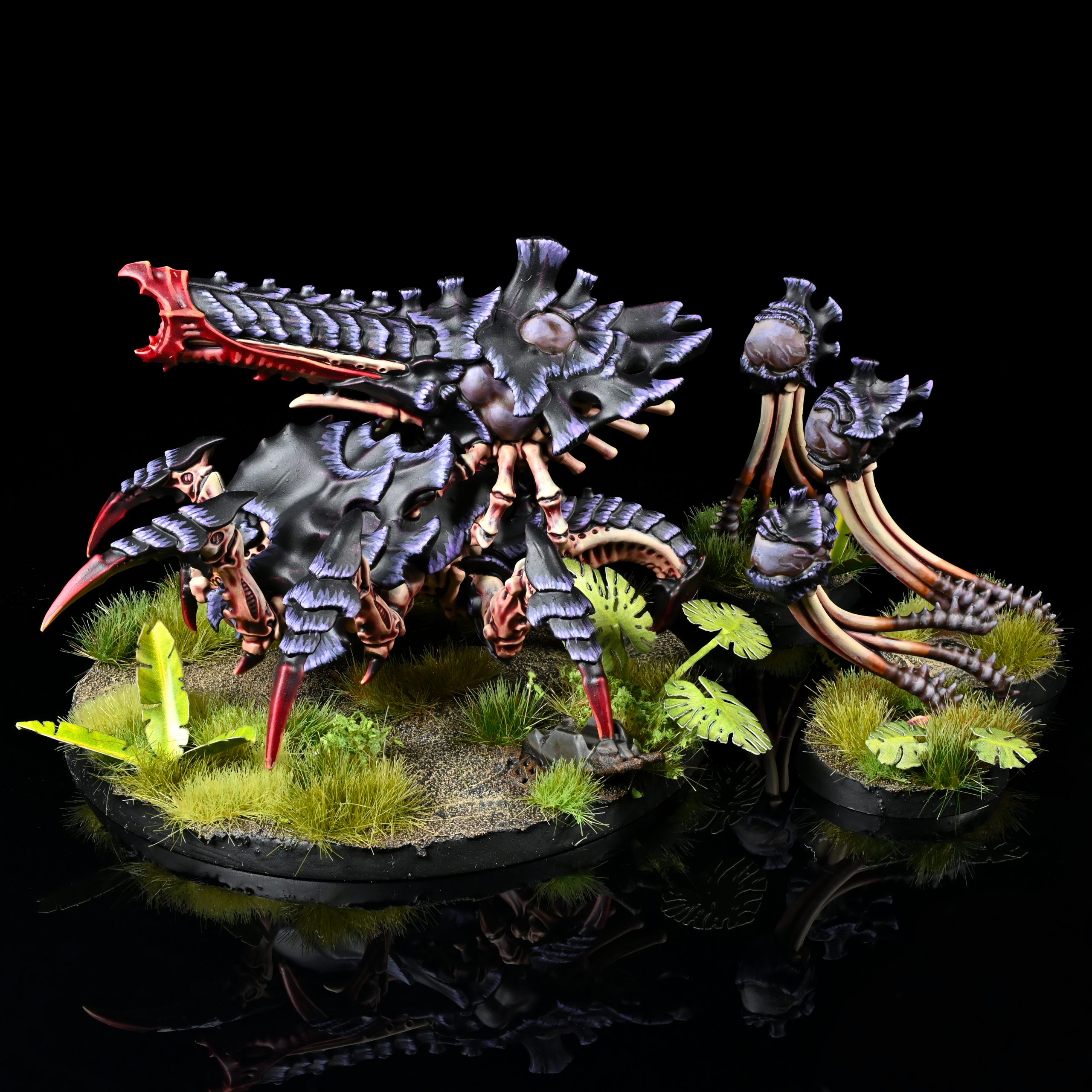
Pyrovores and Biovores both get changes to reflect the new models, though surprisingly less than we’d expected. Both gain +1W, and the Biovore also jumps to a 3+ save (which the Pyro already had). Nothing to sniff at, and the jump from 4 to 5 is very relevant against D2 weapons.
Finally, Deathleaper also has a cool new model and gets…+1 to their armour save. Good chat. Realistically, the big upgrade there is having the VANGUARD INVADER keyword for compatibility with all the shenanigans that detachment brings.
Next up, sidegrades (technically – I have opinions). These affect:
- Ripper Swarms
- Genestealers
- Tyrant Guard
- Sporocyst
Rippers get a change in unit size to reflect what’s in the new boxes (you get one base per Gaunt box), and are now 1-3. This is technically a sidegrade, but functionally a huge upgrade, because you absolutely want three single-model 15pt units that can naturally deep strike to throw away on objectives or block out space. This honestly feels very strange from a design point of view, as it’s extremely good in a way that doesn’t feel particularly fun or interesting. Functionally, however, put 3×1 in every army and think no further on it (and it does help mitigate the dialing back of Biovores).
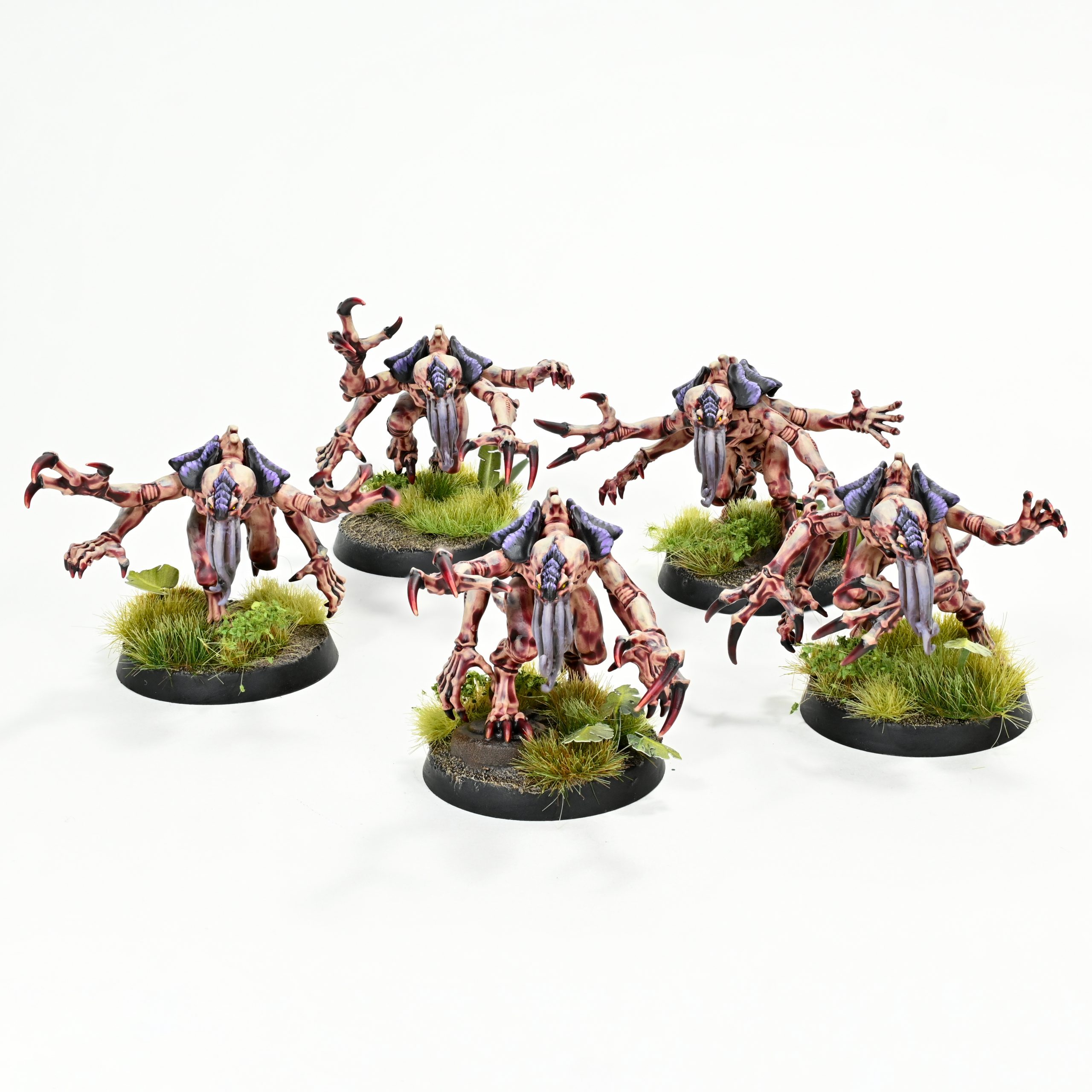
From “functionally a buff” to “functionally a nerf”, Genestealers change from getting RR1s to wound all the time and full wound re-rolls against a target on an objective to having RR1s to hit all the time, and adding RR1s to wound against a target on an objective. That does make them a bit more reliable at mopping up enemy small stuff, but significantly weakens them against bigger targets, because you can’t go fishing for Devastating Wounds with a Broodlord. That’s an issue, because they’re pricy enough that you kind of need them to be able to contribute into larger stuff when it matters. I do think that there’s enough new stuff that incentivises them in this book that you’re more likely to see them after than you were before, but this does hurt that.
Finally, the Sporocyst. GW have taken a look at the very swingy previous version of Hive Defences and gone “perhaps not”, changing it to just give you a free Overwatch, but also doubling the number of shots on the guns to compensate. It also gets a boost to D2 on its melee if stuff tries to tag it. None of this feels like it massively affects the decision to take one – what might is that now you can only seed spore mines from one Biovore a turn, other options to do similar become more attractive. Probably too expensive, but maybe?
Lastly, nerfs. These affect
- Tyrant Guard
- Biovores
- Harpies
- Lictors
- Raveners
- Psychophages
- Tyrannofexes
- Neurogaunts

Tyrant guard could be argued as a sidegrade if you squint, but I’m pretty comfortable calling it a nerf – their crushing claw profile loses an attack and gains Twin-Linked, but their bone cleaver profile (probably the best) loses Twin-linked, now looking pretty anemic. That’s a shame, as there’s lots of stuff in this book that makes you want to take a squad of these, and we’re almost wondering if the latter bit is a mistake given that the weapon set includes a lash whip, which gives Twin-linked in most places.
Biovores and Harpies both get the nerf that Tyranid players were dreading and everyone else was anticipating – only one of each type of unit can Seed Spore Mines per turn. This likely cuts most armies down to one Biovore unit, and incentivises taking lone Ripper bases to compensate. The Harpy may still end up coming out of this book looking way better despite this – the point cost on the page is way lower than the current, and it has the VANGUARD INVADER tag to let it play well in that detachment.
Basic Lictors lose their invulnerable save, which is kind of a shame – presumably those sneaky Neurolictors stole it. This means you probably take one of these for the free Ingress, but go with Neurolictors for the rest of your sneakin’ needs. Another speedy friend, the Ravener, also gets a mild nerf, now having to choose between guns and a 4+ save (dropping to 5+ base).
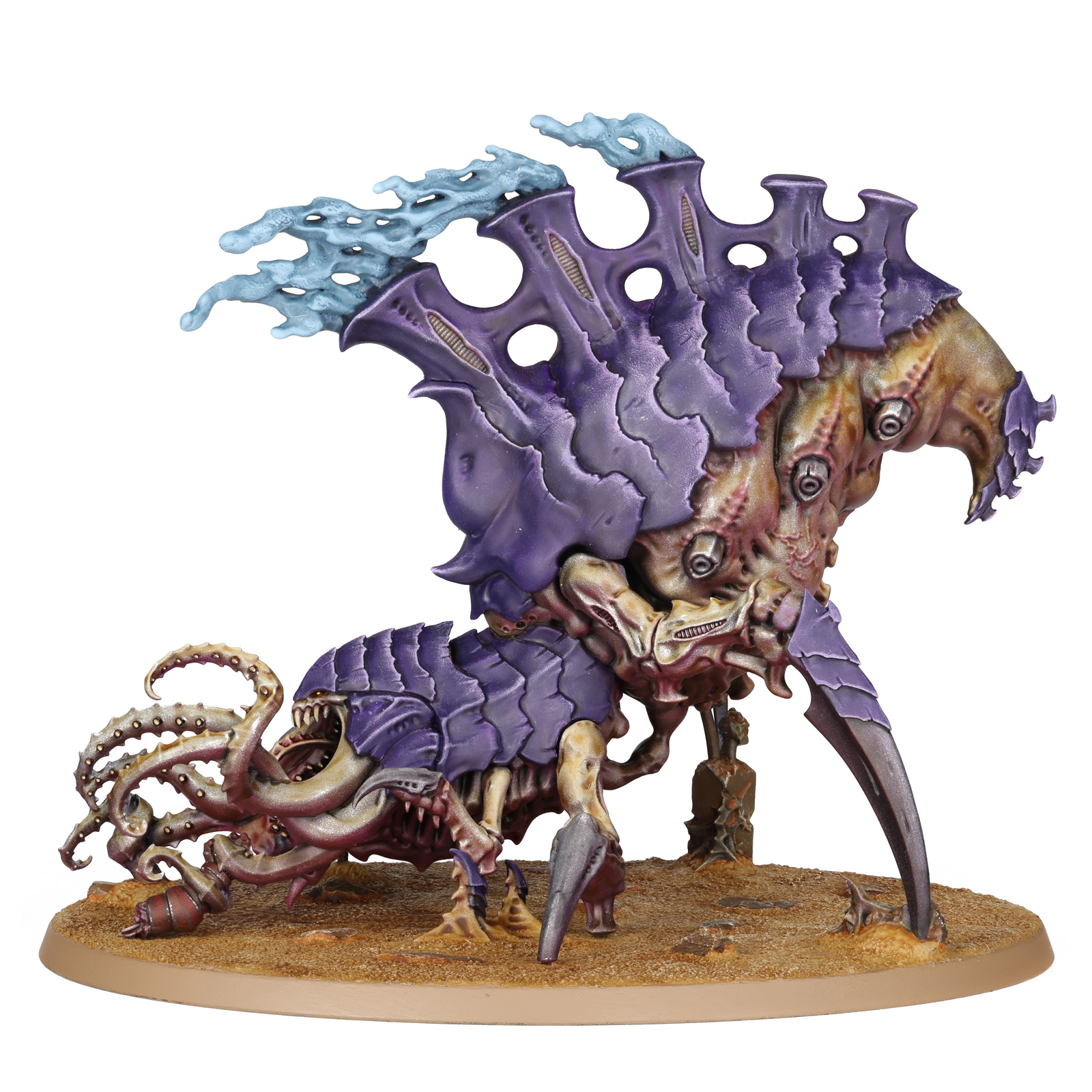
Psychophages get their melee profile dialed back to Anti-Psyker 4+ instead of 2+, and we can all hope and pray that this is indicative of GW realising between the Indexes going to print and this book doing so that the Anti– and Devastating Wounds combo needs to be handled with care. You were mostly taking these for the Feel No Pain aura, so whatever. Similarly unlikely to ruffle many feathers is a change to Neurogaunts, who cannot “chain” Synapse onwards between multiple units of them. Had it even occurred to you to try and do that? No? Probably fine then.
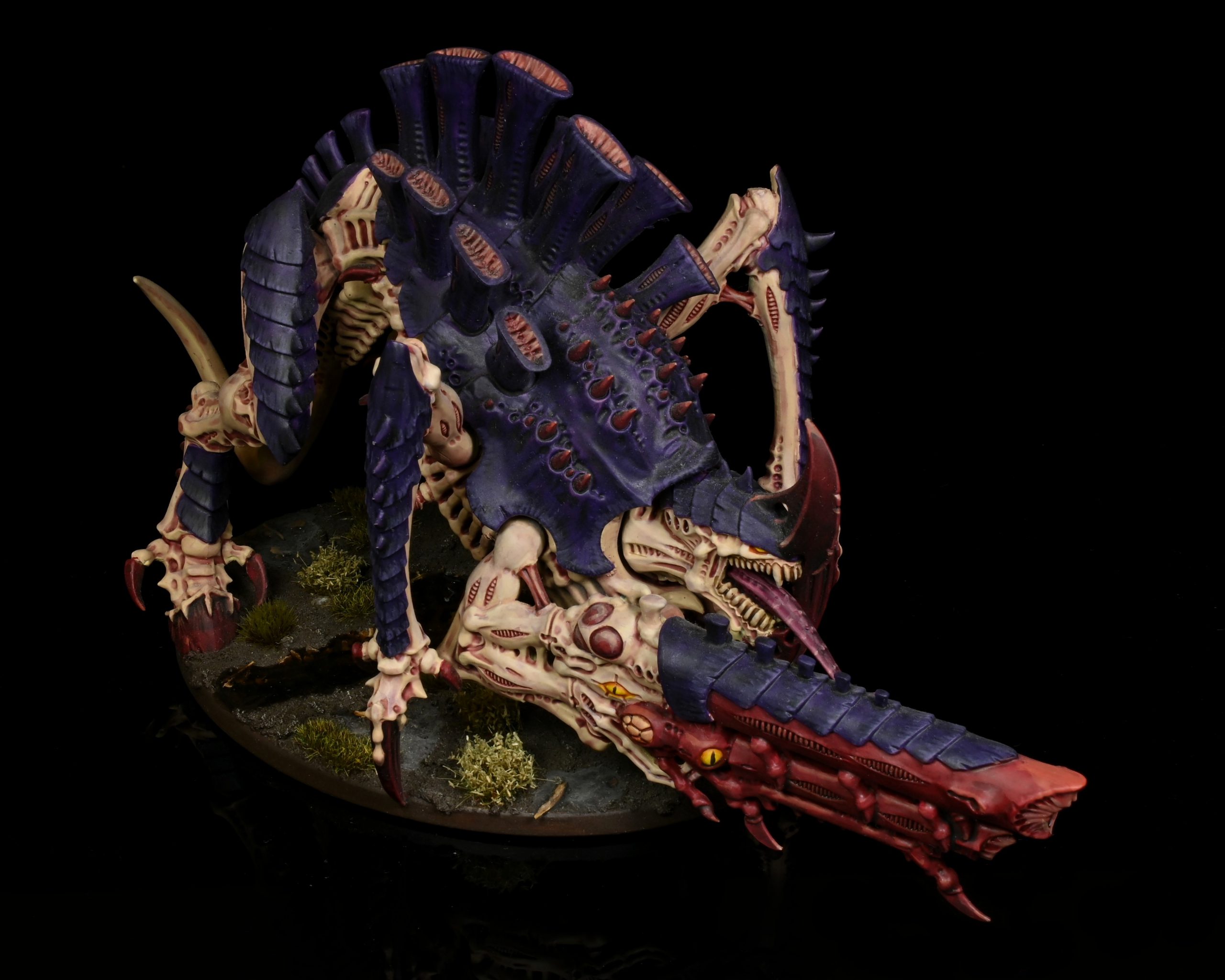
Finally, and a big blow, the Tyrannofex has its damage reduction replaced by a once-per-game ability to reduce the damage of an incoming attack to zero. Funny, but nowhere near as good as always-on damage reduction, and also problematic against Devastating Wounds, as theoretically you trigger this when an attack is allocated, which those never are. In practice, I suspect we’ll see an FAQ of “it still works, just cause”, similar to the current commentary on damage reduction against them. Assuming that gets done, no-selling a thundercoil harpoon will be an occasionally hilarious treat, but otherwise these are now far harder to justify over cheaper options like Maleceptors and Exocrines.
New Ways to Use Units
If anyone has a snappy title for this section, answers on a postcard.
With five new detachments to play with, some units are obviously going to be worth a renewed look.Some of this is pretty obvious – you don’t need me to tell you that big Gaunt units are good in the Unending Swarm, and that you could certainly try building around Harvesters in an Assimilation Swarm.
The two detachments with more wide-ranging impacts (both because they affect more units and because they’re good) are the Synaptic Nexus and Vanguard Onslaught.
Let’s look at the Nexus first. This brings some big incentives for:
- Maleceptors
- Zoanthropes
- Tyrant Guard
- Neurotyrants
- Winged Hive Tyrants
- Tervigons
Maleceptors and Zoanthropes aren’t complicated – these are already some of the best Tyranid units, and this detachment makes them even better. Maleceptors can benefit quite substantially from the +1 to hit in melee, and both love Irresistible Will to push their output sky high. Six Zoanthropes were already super deadly, six with re-roll 1s on hits and wounds are edging towards obnoxiously deadly, and also being able to fall back and shoot with Override Instincts makes them very tough to stop.Tyrant Guard are also already seeing some play in lists, and now if they pal around with a Tyrant or Neurotyrant they’re eligible for Reinforced Hive Node to reduce AP. They’re also broad beneficiaries of the detachment ability, getting actual value from all three modes.
Neurotyrants both help glue this detachment together with their Neuroloids, making it more viable to send some stuff out hunting while retaining bonuses (which feels like it could be good with a Trygon), while adding Power of the Hive Mind to their gun makes them substantially more of a threat to opponents.
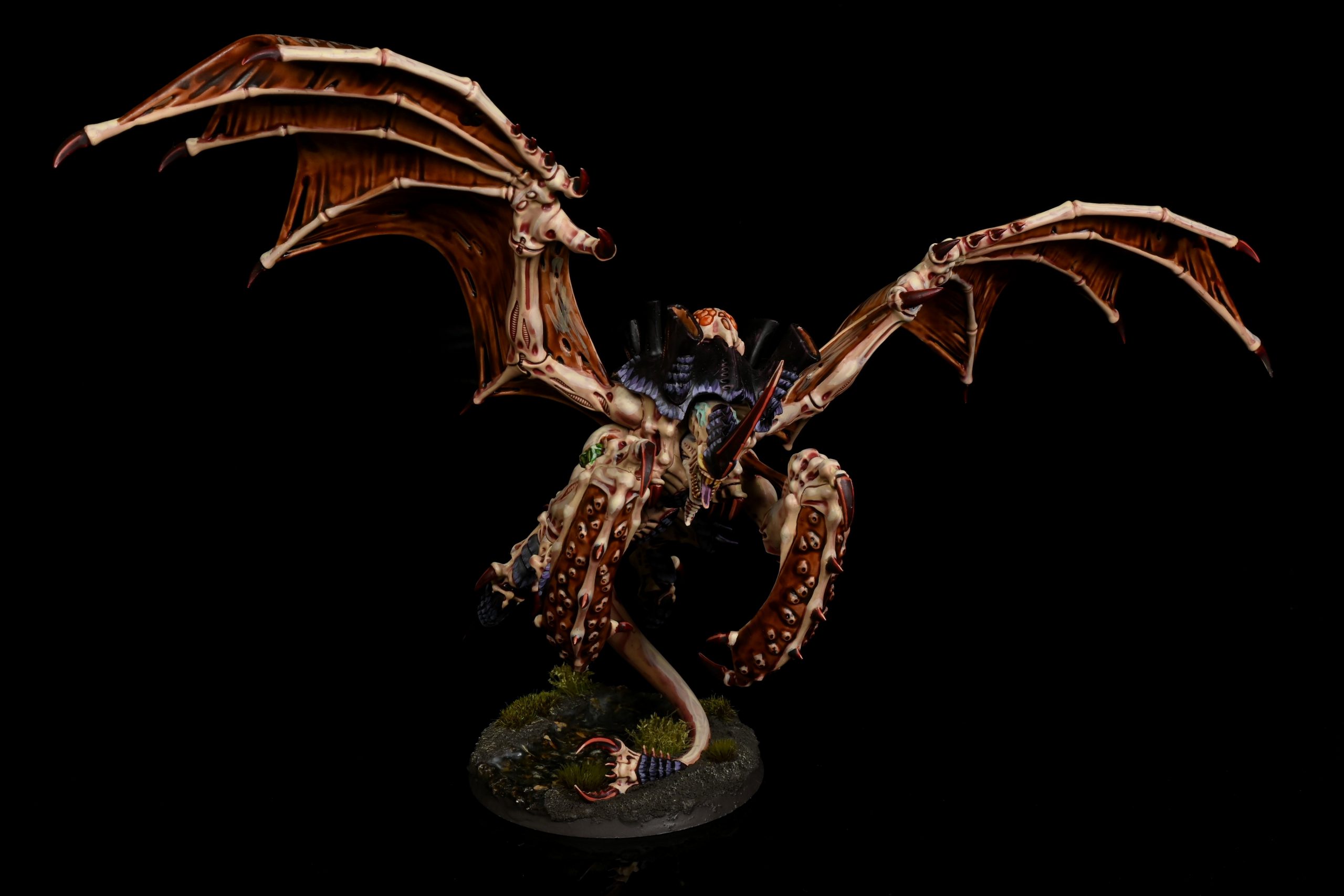
Lastly, and also winning from Enhancements, both Flyrants and the Tervigon love being able to take Synaptic Control for -1D, and the Tervigon is also tough enough at baseline that it can be a good place to put Psychostatic Disruption. The Flyrant feels like the bigger news here, as -1D pushes it towards being tough enough for serious use, especially as it can also use Hive Node on top of its 2+ save. It does still have a vulnerability to Devastating Wounds, but even then this detachment helps – if you see a Wraithknight across the table, put it in Deep Strike, switch on the +1 to charges on the turn it comes in, and use its free Stratagem to re-roll if needed, getting you to a solid 66% chance of landing the charge, and still needing to be handled if not.
Moving on to the Vanguard Onslaught, beyond some of the obvious stuff (hi Deathleaper, hi Gargoyles) this incentivises:
- Winged Tyranid Primes
- Genestealers and Broodlords
- Harpies
- Mawloc
- Zoanthropes (again)
- Winged Hive Tyrants (again)
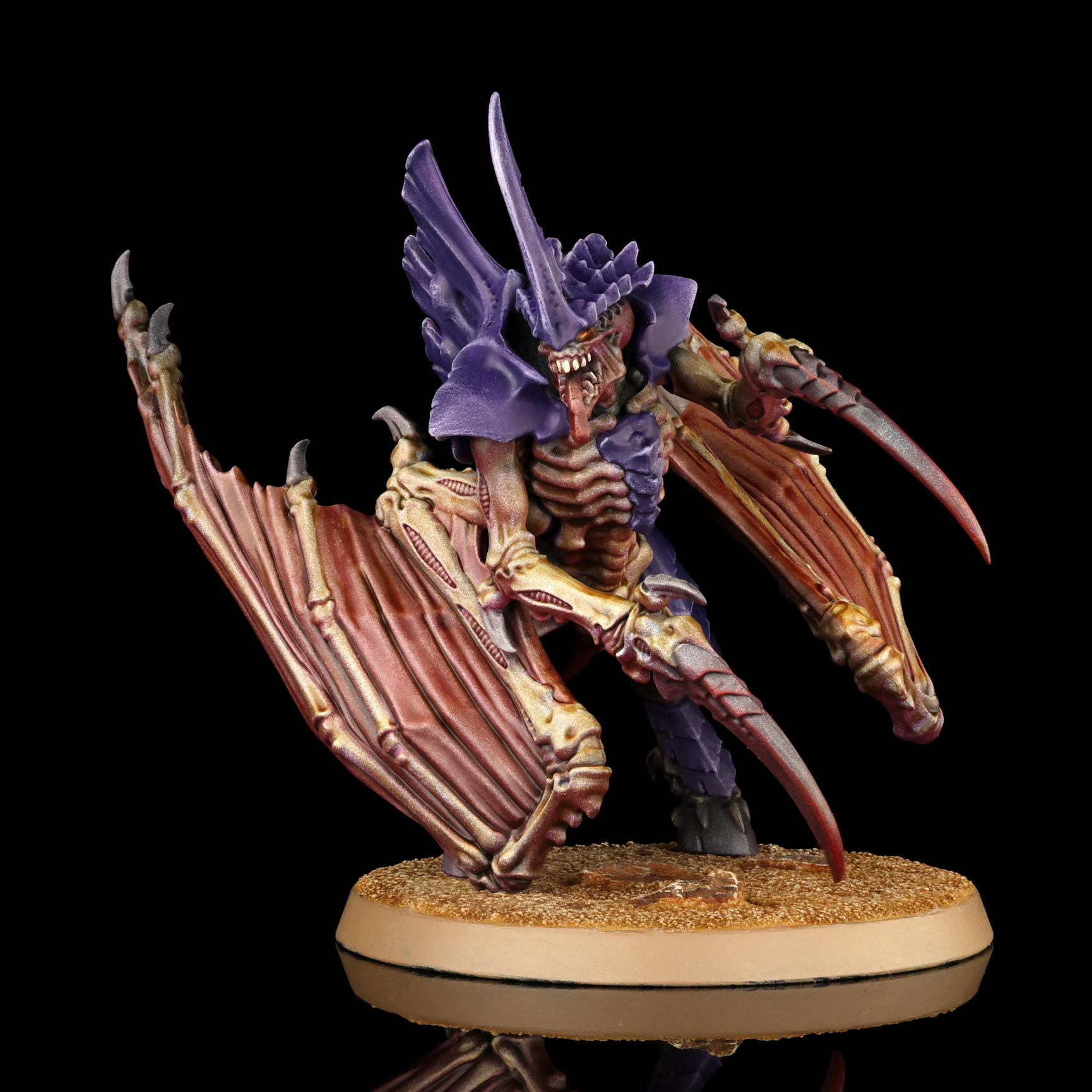
Since the Winged Prime appeared with no sign of new Shrikes, we’ve all been scratching our heads as to what exactly it’s for and we finally have our answer – conferring VANGUARD INVADER on Warriors. In particular, a full unit of shooty Warriors with one of these seems pretty legitimate – it runs you 205pts at book prices, and gives you decent ranged output from a unit that’s tough to shift, compatible with all the sneaky tricks, can’t be locked down in melee, and has reasonable countercharge punch for the price. The Prime is also a decent place to drop Neuronode, as it doesn’t need any of the other Enhancements. Melee Warriors also look kind of fun, but the vastly steeper price tag makes them harder to justify.
Genestealers and Broodlords remain in a weird price bracket where they’re not bad exactly, but you need more broad capabilities from a unit that’s going to end up running you 280pts. If they’re going to get there anywhere it’s here though – the detachment gives them back their beloved Advance and Charge, which makes them a legitimate turn one threat in combination with Scouts, and using Neuronode you can adapt with a high degree of precision to the exact lay of the land. I suspect the conclusion ends up being that a full unit is still just too much, though maybe five (or honestly even just a solo Broodlord with Stalker to make sure they land the damage) as a disruption threat could get there, especially as you could potentially turn on Precision for an early spike of a key character?
Harpies, shockingly, enjoy being able to adaptively redeploy and really enjoy being able to say an opponent straight up can’t shoot them with Unseen Lurkers. You can also at least consider taking them in Aircraft mode in this army, since they can come in turn 1 with Seeded Broods.Not sure you need to, but you could, and with bombing and spore mine seeding capabilities they do actually benefit from a big movement. Also very interesting with Seeded Broods is the Mawloc, because bringing their massive mortal AoE ability down turn one can be super nasty. This is one of those nice things where you don’t actually have to spend the CP and do it for it to be valuable – just the fact that you could forces the opponent to change how they deploy, and if they get it wrong or don’t bother then you punish them. It’s also a big chunky move blocking speedbump after that, and can cause problems for lists that deploy very light on the board if you steal a march on them and put it amidst their lines.
Zoanthropes are worth highlighting again because they’re probably the best non-Keyworded users of a bunch of the stuff here that allows it. Hypersensory Scillia lets them avoid reprisals while Invisible Hunter enables jumping back into reserves, letting them massively reposition if the opponent is hiding for them. They’re also a consideration for putting in Strategic Reserves and using with Seeded Broods to bring in turn 1, as that gives you some guaranteed big shooting that your opponent can’t really do anything about.
Finally, the Flyrant – again. Games Workshop just can’t quit you. Like with the Harpy, Unseen Lurkers here is phenomenal, because you can’t kill what you can’t shoot. Access to the Chameleonic relic is also pretty fantastic, as stacking Stealth and always-on Cover with their 2+ is a pain to get through. Good news all-round for players who have been suffering during this (very brief) interlude of Flyrants not being useful.
Much, as they say, to consider. I will say – as first impressions of how new Codexes go, I really like this. Taking an existing familiar roster and seeing it from a bunch of new angles is fun, and much less disruptive or risky to the metagame than the Codex essentially being a full overhaul of the faction. I don’t doubt that as we get further into the edition some books will diverge further from their Index, but this feels like a super solid start to things.
How They Will Play
This is a much harder question to answer than in previous editions, because the whole point of the detachment system is to provide quite different ways to play an army. If there’s a way to summarise it, it’s probably “pressure” – the best detachments here all provide you with tools for putting the opponent under your clawed heel and keeping them there, and the Norn Emissary is an exceptional anchor to work around while doing so. Even after the change to Biovores, Tyranids also still excel at Tactical Objectives, as Neurolictors and single-base Ripper units are great new tools for this. That means that if you can keep your opponent pressured on the Primary, you can build up an insurmountable all-spectrum points lead.
I do think you need to be focusing more on winning via points than just blowing the opponent off the table. The Synaptic Nexus might give Maleceptor and Zoanthrope-heavy builds a consistent shot at this, but Tyranids have a lot of weaponry in the S7-9 bracket, which is fine for dealing with smaller stuff, but can drop off against really big targets. You can deal plenty of damage, but you don’t want to end up trying to beat Knights in a straight gunfight across the table, basically, so use the tools that the Hive Mind has given you.
Army Lists
As you might have detected from the rest of the article, the detachments that inspire me the most are the Vanguard Onslaught and the Synaptic Nexus, so we’ll close with a list from each. I’m sure both could be optimised further, and there will be some stuff I’m taking because it’s cool rather than the most optimal, but hopefully they provide food for thought.
For both of these, I’ve used the points values from the Munitorum Field Manual where they exist, and the Codex where they don’t. I’m sure that will be all change soon enough, but my read is that this is the “most correct” way to handle it.
Sneaky Bugs – Vanguard Onslaught
Characters
Deathleaper 80
Winged Tyranid Prime 80
– Enhancement – Neuronode 30
Winged Hive Tyrant 190
– Enhancement – Chameleonic 15
Winged Tyranid Prime, Warlord 80
– Enhancement – Hunting Grounds 20
Monsters
Norn Emissary 285
Mawloc 145
Infantry
Tyranid Warriors with Ranged Bio Weapons x6 140
Tyranid Warriors with Ranged Bio Weapons x6 140
Gargoyles 75
Zoanthropes x6 180~
Von Ryan’s Leapers 75
Other
Parasite of Mortrex 90
Lictor 75
Neurolictor 60
Neurolictor 60
Neurolictor 60
Rippers 15
Rippers 15
Rippers 15
Biovore 65
This list is designed to cause absolute chaos amidst the enemy’s lines and be an absolute scoring engine. I think there’s a risk that Warriors don’t get there even with all the buffs, but I’d certainly want to at least try them, and this seems like a good place to do it. Even in this otherwise sneaky build, I think a Norn is great to try and lock up an objective.
Brainy Bugs – Synaptic Nexus
Characters
The Swarmlord – Warlord 250
Winged Hive Tyrant 190
– Enhancement – Synaptic Control 20
Deathleaper 80
Monsters
Norn Emissary 285
Maleceptor 165
Maleceptor 165
Maleceptor 165
Infantry
Zoanthropes x6 180
Zoanthropes x3 90
Zoanthropes x3 90
Neurogaunts 45
Neurogaunts 45
Other
Neurolictor 60
Neurolictor 60
Rippers 15
Rippers 15
Rippers 15
Biovore 65
Far less subtle, far more directly murderous. Here you want to use the Maleceptors and Emissary to fully punch a hole in the opponent’s army, all while the buffed Zoanthropes blast away and your utility stuff scores you point. Swarmy makes it in here, because you’re going to want a lot of Command Points to work with. I was a bit sad not to be able to squeeze Psychostatic Disruption in, and it does highlight that Tyranids don’t really have any dirt cheap characters to hold a relic any more.
Final Thoughts
It’s a good landing, folks. While it’s a shame a couple of the detachments are a little underwhelming, this book in general seems great, there’s some nice design on show, and we’re excited to see what people do with it (and what units we’re incredibly) wrong about. Don’t forget to check out our Painting Guides, Crusade Reviews and Combat Patrol articles coming soon, and prepare for a new era of the Hive Mind coming soon to a table near you.


